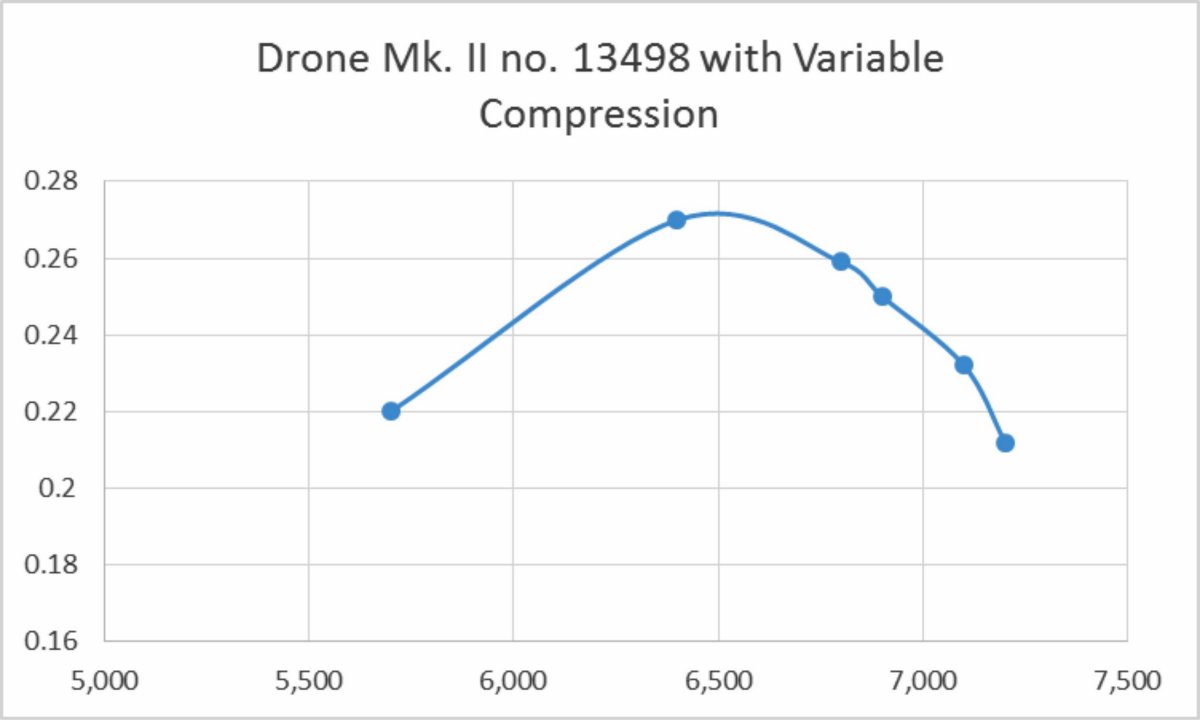
|
|
An All-Time American Classic - the Drone Diesel
With that introduction, no knowledgeable model engine aficionado could be in any doubt at all that I’m talking about the famous Drone Diesel of 4.85cc (0.297 cuin.) displacement. This fine engine was manufactured in two quite distinct variants by Drone Engineering Inc., initially of 125 Broad Street, Elizabeth, New Jersey, but later giving their address as 851 Anna Street in the same city. It was in production during the years 1947-1949 and was arguably the most successful of all American diesels both in commercial and competition terms. Some 15,000 units of both models combined were produced during those few years, a high figure for an American diesel. The engine was so well built and so durable that a substantial proportion of that total still survives today. My original article on this subject appeared in May 2010 on the late Ron Chernich’s fabulous “Model Engine News” (MEN) website. However, my greatly-missed mate Ron left us in early 2014 without passing on the access codes to his heavily encrypted site. Consequently, no maintenance of that site has since been possible, making it inevitable that a slow but inexorable deterioration is taking place over time. It’s this issue that has led me to transfer a number of what I consider to be my more important articles over to my own site. This is one of them. It's my intention in this article to summarise the genesis, development and untimely demise of the Drone as well as to set the record straight in a few areas in which there has been a measure of misinformation circulated in the past. I’ll also provide some detailed notes on operation and performance based on present-day experience. However, it's always best to begin at the beginning! Origins
One of these was the French Micron fixed-compression diesel of 4.99 cc displacement, examples of which had begun to appear on American flying fields by 1946. It was this engine which inspired the design of the Drone Diesel which is the central subject of this article. The Drone Diesel was designed by the well-known modeller Leon Shulman, who had been born in 1920 in Brooklyn, New York. Although he was only 26 years old when the Drone was conceived, Leon was already a very experienced modeller with a high standing in the US competition arena and a visible presence in the US model trade. He had actually taken his first step towards an active commercial involvement in the model Leon thus had something of a "name" to attach to any new modelling product with which he might become associated, backed up by a considerable amount of marketing experience. He was also blessed with an open and inquiring mind, and it's clear that he was very impressed with the 5 cc Micron fixed-compression diesel. That fine engine had achieved an outstanding contest record in early post-war European competitions, which certainly made it a design worth studying. By 1946, when he first became aware of the Micron diesel, Leon had become a regular competitor in control-line events, an activity with which he was to remain involved until 1951, winning several Regional and National competitions along the way. He was thus pre-disposed towards the development of better equipment for control-line use.
According to the late long-time Drone user Gus Munich, who was "there" during the engine's hey-day and knew Leon Shulman very well, the idea of designing and producing an American fixed-compression diesel along the general lines of the Micron had its genesis in coffee-shop discussions between Leon and others at the 1946 US Nationals. Following these discussions, Leon secured financial backing from a close friend and got started on the design of the engine as well as the assembly of the required dies and tooling. The Drone was Gus Munich's all-time favourite engine by his own open admission. His personal reminiscences regarding the engine were published in MECA Bulletin no. 71, issued together with swap sheet no. 88 in January 1981 (over forty years ago - how time flies!). Gus's insights still make fascinating reading today, and I freely acknowledge that both my personal enthusiasm for the Drone and the basic material for the following article stemmed initially from my reading of Gus's text. I advise anyone who can gain access to a copy to read Gus's original comments. Where my information differs from that set out by Gus, it is only on the basis of persuasive evidence and later experience which have become available since Gus's time of writing. The First Model Drone
For unknown reasons, this version apparently never actually reached the hobby shops - there are no known surviving examples. We only know what it looked like from a couple of pre-release advertisements which were placed in “Model Airplane News” (MAN) and "Air Trails" magazines in early 1947. The engine was identified in these advertisements as the “Gold Crown Drone "B"ee”, a name by which it is still sometimes known.
One significant departure from the Micron was the bore/stroke relationship. The Micron used a bore and stroke of 17.00 mm x 22.00 mm respectively, giving that engine a displacement of 4.99 cc in keeping with the European Class B standard of 5 cc. However, this worked out as 0.304 cuin, which was just over the limit of 0.299 cuin allowable in American Class B competitions. Since Leon naturally wanted an American Class B engine, the Drone utilized a modified bore and stroke of 16.67 mm x 22.22 mm, making it slightly more under-square than the Micron and giving it a displacement of 0.297 cuin. (4.85 cc). These rather long-stroke measurements were well suited to the relatively low design operating speeds which the use of fixed compression pretty much dictated.
At 275 gm (9.7 oz.) complete with tank, the Drone was certainly no lightweight. However, it dispensed with the cumbersome and heavy spark ignition equipment while seriously out-torquing the spark ignition opposition which was all that it had to contend with during the pre-glowplug era in which it was introduced. In terms of its effective power-to-weight ratio, it probably at least equalled the best of the 1947 opposition while also having far less to go wrong.
As assembled by the factory, the exhaust was located on the left side of the engine (seen in the direction of flight from the rear). This was because the recommended control-line mounting position for the engine was in the sidewinder configuration, and locating the exhaust on that side theoretically reduced the amount of dirt potentially ingested during landing of models that were not equipped with landing gear. The design was such that the engine could be re-assembled with the stack on the right as long as one remembered to switch the piston around as well! It's astonishing how many first model Drones are encountered today with their pistons reversed! The sturdy one-piece steel crankshaft had a plain disc crankweb and a generous journal diameter of 0.471 in. (11.96 mm). It was provided with a rectangular induction port which gave very rapid opening and closing of the induction system. The shaft ran in a main bearing which was cast integrally with the crankcase and incorporated a bronze bushing. The front of the shaft featured a short extension of reduced diameter with a pair of flats milled into it on opposite sides, and the alloy propeller driver keyed onto this extension. A further threaded extension accommodated the prop itself as well as the prop-nut and prop washer.
The back tank appeared on most examples of the first model Drone, although a few of the later engines in the high 9000 serial number range were apparently sold without this fitting - the odd tankless example has been encountered in a box in which the insert lacked the required cut-out to accommodate a tank in the first place. Presumably stocks of the tank were exhausted before all of the other first model components had been assembled into engines for sale. There was no point in making more tanks because the first model was scheduled for replacement anyway by that time.
The serial numbers for the first model Drone were stamped on the upper surface of the right-hand mounting lug (looking forward in the direction of flight). They went from 1 to around 10,000 - this statement is supported by the fact that I own first model Drones 441 and 9796 from opposite ends of this range as well as several in between. The engine sold for the then considerable price of $21.50. It wasn't cheap, but the quality and performance were both high. In fact, the standard of workmanship throughout was of the very highest order, putting many contemporary British makers to shame. Gus Munich mentioned having met a former employee of The engine was most attractively finished, with the black-anodized main castings contrasting nicely with the plain metal highlights and gold-anodized cylinder head. It was packaged in a sturdy black cardboard box with gold lettering. The instruction sheet provided with the engine was both comprehensive and accurate. If followed, the very clear instructions which appeared on the sheet could scarcely fail to ensure good results. The guarantee provided with these engines was interesting - there was no time-limited guarantee of the more usual kind. The document first made the statement that "this engine has been run at the factory and was started by hand as a final check. Only Drone diesel fuel was used." The actual guarantee itself was limited to a specific assurance that the engine was "free from material defects at time of purchase". Nothing was said about defects that might develop after purchase!
I can envision a few "material defects" that might not become obvious unless the engine was dismantled or subjected to further running time! However, the ruling criterion was the performance out of the box - the very clear message was that if the engine failed to start and run properly using the specified fuel and procedures, it would not be due to the factory sending out an inoperable engine! The fact that all engines were test-run at the factory meant that there was little or no chance of inoperable engines getting out to the public. The company was clearly and expressly relying on this. Still, if the engine failed to perform for its new owner there must be a reason of some kind! The company's preference was to have it returned to the factory for inspection and repair if necessary rather than have the owner try to fix it for himself. One wonders how many of the engines returned (assuming that some were) proved to have no defects, more or less demonstrating that the problems were owner-related. What would the company have done in such a case? They weren’t guaranteeing the owner’s ability to start the engine - they were guaranteeing the as-supplied engine's operating condition if handled properly.
The manufacturer's recommended fuel (specified both in the instructions and on the guarantee) was either the pre-mixed Drone fuel or a blend of 75% ether and 25% SAE 20 mineral oil - presumably the two were more or less the same. The addition of a little SAE 30 oil was suggested during the break-in process. The recommended airscrew for control line stunt flying, for which the engine was primarily intended, was an 11x10. Using this combination, starting was foolproof (present-day urban legends to the contrary) and running extremely consistent, as I can personally confirm from extensive first-hand experience. By comparison with the spark-ignition alternative which was all that was then available, the Drone really stood out in these respects, especially in the context of control-line flying where dependable runs of up to 10 minutes were the standard requirement as opposed to the short runs typical of free flight operation. Leon Shulman was very active in promoting his new product, making a number of extremely successful demonstrations of the motor at various trade shows as well as sponsoring a series of contests with Drone engines as the prizes. As a further promotion, he even produced a limited number of custom pith helmets having a Drone cylinder and head on top along with Drone decals on the side! Boy, would I love to have one of those today! The Drone cause was further aided by several positive commentaries which appeared at various times in the contemporary modelling media. An extremely positive review of the engine was published in the August 1947 issue of "Flying Models" magazine, while the rival magazine "Air Trails" published an equally positive evaluation at around the same time. The latter review specifically stated that the engine "was easily started and ran very consistently". The September 1947 issue of "Air Trails and Science Frontiers" featured an article by Jim Noonan entitled "The Development of Diesels", in which the Drone received high praise for its "high speed, smooth running and lots of noise"! The latter comment was somewhat contradictory to the claim in the factory instruction In addition, a contemporary user's view of the Drone appeared in the December 1947 issue of "Model Airplane News". Author Jack Bayha commented as follows: "We have been flying with the Drone for several months now and find its .297 displacement gives adequate power to handle ships which would be considered as excessively heavy for an equal displacement gasoline engine. We have had particular fun with Drone-powered P-39 scale models. The Drone can take these plastic prefabricated ships along at a lively 60 mph and has adequate power for stunts and emergencies. Leon Shulman's peppy little diesel runs equally well with a 10x12 or an 11x10 prop." In view of all this promotional activity, it should come as no surprise to learn that the Drone quickly achieved a high level of acceptance among US control-line stunt flyers. Users of this engine cleaned up at major stunt contests in America during the year of its introduction. The 1947 US Nationals and the prestigious Mirror Meet both fell to the Drone, along with numerous other lesser contests. The company’s advertising highlighted these successes very prominently. The factory was kept busy keeping up with demand, and life was good! The Drone even managed to cross the Atlantic and appear in small numbers on flying fields in Britain and elsewhere. The highly influential British power modeller Colonel C. E. Bowden included a very positive description and an illustration of the first model Drone in the 1949 second edition of his classic book "Diesel Model Engines". He reported having used the engine successfully to power an 8 foot span free flight model - an impressive feat for a 5 cc motor. However, all was not perfect. As the operating hours built up on some of the first-model Drones which reached the hands of active competition modellers who did a lot of practising, it became apparent that the main bearing was not up to the job in the long term. The journal was very large by the standards of the day and one would have expected the shaft to wear very well in conjunction with its bronze bushing, but apparently it didn't wear well enough.
As the main bearing wore, the shaft was no longer constrained at right angles to the bore, and accelerated rod bearing wear naturally followed. As this occurred, the piston location at top dead centre became progressively lower, resulting in a decrease in the geometric compression ratio of the engine. This in turn naturally affected performance to some degree. In short, the engine would not hold peak performance over the long haul, although some of the lost performance could doubtless be recovered at least temporarily either by lowering the head or increasing the oil content in the fuel. Having said this, I must point out that based on considerable personal experience of the engine, a first model Drone which is run in the optimum condition without detonation and with an adequate supply of good-quality oil appears to be good for many tens of hours of strong running. Even so, the bearings will likely wear out long before the piston fit is worn anywhere near to the point where a rebore is required - Drone pistons seem to last forever, and it's extremely rare to find a piston/cylinder combination that is anywhere close to being clapped out. Regardless, this wasn't good enough for Leon Shulman - he prided himself (with considerable justification) on building his engines up to a standard rather than down to a price! So he set to work to re-design the entire engine with a view towards rectifying the problems which long-term use of the first model Drone had uncovered. The result was one of the all-time classic model diesel engines, regardless of origin. Let's take a close look at it. The Second Model Drone
The new variant, which was introduced in the second half of 1948, had the same bore and stroke as its predecessor but was changed in almost all other respects. It featured a completely revised one-piece main casting incorporating the crankcase, the backplate, the bypass and the cylinder barrel together with a left-hand side exhaust stack which obviously could not be reversed. In addition, the beam mounting lugs were considerably stronger. The word "Drone" was cast at the front of the cylinder barrel rather than on the bypass at the side. The main bearing was now mounted on a separate cover plate which bolted onto the front of the crankcase with three long bolts and nuts. A gasket was used to ensure a seal. This arrangement allowed for the possibility of mounting the engine radially if desired. The venturi intake was cast integrally with the main bearing rather than being a separate screw-in item as on the first model. The needle valve was changed to a shorter alloy thimble than that used previously.
The same means of securing the alloy prop driver to the shaft were employed. However, the keyed shaft extension with its two flats had a larger diameter, with the centre of the driver modified accordingly. This would logically result in greater durability in service. The former forward extension of the shaft to accommodate the actual prop was replaced by a separate prop bolt which screwed into a threaded hole in the front of the shaft. This was a good move, since a hard crash would now merely result in a bent prop bolt rather than a bent or broken shaft.
However, it didn't stop there - a further benefit conferred by the addition of the ball-race was even easier starting. Much of the challenge involved in starting large diesels of the pioneering era arose from their admitted tendency to "self-brake" during starting as a result of the relatively high compression resistance and bearing drag. This resulted in a tendency for the engine to fail to swing all the way over from the initial firing stroke to the next unless a sufficiently large prop was used and/or a really sharp flick was employed. Ron Warring actually included an accurate retrospective commentary on this issue in his March 1955 "Aeromodeller" test of the 5 cc Miles Special diesel. Although the first model Drone was a perfectly straightforward starter, the ball bearing greatly improved the second model's ability to "carry over" during starting, perhaps requiring a slightly less forceful starting flick in consequence. The improved "flickability" of the new model also facilitated an increase in the nominal No tank was supplied with the second model, probably because the first model tank was unsuitable for control-line stunt use and most had likely been discarded by their owners in any case. In consequence, the majority of the tanks seen today on Mk. I Drones are latter-day replicas. In terms of weight, the elimination of the tank and main bearing bushing were offset by the addition of the ball race, the result being that the new model weighed 278 gm (9.80 oz.), a fraction more than its predecessor. The new model came in a rather flimsy fold-up box as opposed to the sturdy high-class rigid box formerly used. The introductory price remained unchanged at $21.50.
The instruction leaflet issued with the revised model was if anything superior to that for the first model - it's hard to see how the manufacturers could have been any clearer regarding the correct approach to using the Drone. Anyone who read and followed these instructions should have experienced no difficulty in starting and running one of these units. The second model Drone got off to a very promising start when a model powered by a pre-production prototype finished third in the control-line stunt category at the 1948 Mirror Meet. However, at this event the new model had to give best to its plain-bearing predecessor! Fran McElwee not only won the control-line stunt event using his "Defender" design powered by a first-model Drone (mounted in the upright position!), but also took first place in the radio control event using a first-model Drone-powered airplane! Needless to say, this was good enough to Despite its failure to defeat its predecessor on this occasion, it was immediately obvious to one and all that from the standpoint of its running and wearing qualities, the revised model of the Drone stood head and shoulders above the first version, and even that model had set a pretty high standard. Another extremely positive review soon appeared in the October 1948 issue of "Flying Models" (by which time the price had been reduced to $14.95) and many confirmed Drone users hastened to replace their Mk. I engines with the new model. Life was still looking good for Leon Shulman and Drone Engineering! From the purely selfish perspective of a present-day collector, this had one very beneficial effect - a lot of dedicated Drone users retired their first model Drones in favour of the new version long before those first models had worn out and in some cases before they had even been run in! As a result, many first model Drones survive today in excellent running condition, never having come close to the end of their working lives during the year or less during which they were in use. Gathering Clouds So far, we've been chronicling a story of unbroken success! During its first 18 months, the Drone had achieved a contest record that was second to none and had been refined into a product that seemed capable of producing contest-winning performance indefinitely. Sales of the engine confirmed the extremely positive marketplace view of its qualities. Leon Shulman had every reason to feel proud of his accomplishments!
It took some time for the new accessory to catch on and for competition fliers to get to grips with its characteristics. However, at that very same 1948 Mirror Meet which had been so completely dominated by the Drone, contestants took note of a number of models which were flying very well indeed using engines which resembled the old spark-ignition powerplants but appeared to run without any form of on-board ignition system. One of these was an unpretentious-looking sand-cast prototype of a motor which some initially took for just another slag engine but which was soon to become widely known as the Fox 35 - the glow-plug had arrived on the US contest scene! The December 1948 introduction of the Fox 35 in production form, along with other similar purpose-built glow-plug motors suitable for stunt flying, heralded the doom of the Drone Diesel. Not only were these engines significantly lighter than the Drone, but they pulled at least as well in flight and ran just as dependably. Moreover, they were cheaper. The Drone was still built very much up to a standard rather than down to a price, and quality at the Drone level doesn't come cheap. The June 1948 introduction of the The blow was initially somewhat cushioned by the fact that Drone Engineering were not totally dependent on their engine manufacturing - they had diversified considerably by this time and were also producing kits, propellers, fuel and accessories to match their engines, including variable-compression diesel heads for the second model Drone and glow-plug heads for the first model Drone. It's a little odd to note in the latter context that complete engines were never sold by the factory as either variable-compression diesels or glow-plug models. One wonders why............. but this information is authoritative since it came from Leon Shulman himself. The late Bert Striegler had some experience with the variable compression head for the second model Drone. He commented that the Drone factory head used a very short contra piston, The whole thing worked extremely well with standard diesel fuel mixes. Bert's head didn’t leak and the compression control worked smoothly. Bert found starting even easier than with a fixed head and felt that the performance of the engine was enhanced by this fitting, although he still agreed that a well set-up fixed-compression Drone was a good starter and a strong runner. Turning now to the Drone glow head, there's a fair bit of confusion surrounding the accessory components that were supplied by Drone Engineering. This is due in large part to the fact that a fair number of second-model Drones were converted to glow-plug operation by their owners - a very simple operation indeed for anyone having access to a lathe. Indeed, a number of individuals reportedly offered conversion services for these engines to assist those who were not equipped to carry out the work themselves. Second-model Drones converted in this way still show up fairly regularly on eBay and elsewhere. This has led to a common belief that such heads were supplied by the factory for the ball-bearing Drone. However, according to Gus Munich, an original Drone user who drew much of his information from direct long-term The genuine Drone glow heads were simply standard 1st model heads which had a centrally-tapped and smoothly contoured recess added to accept a standard glow plug. Their design was very much a compromise - there’s little doubt that far better results would have been achieved through the production of an all-new head expressly configured for the purpose. The 18:1 compression ratio established by the standard Drone Diesel head was obviously way too high for glow-plug operation. The necessary reduction was accomplished rather inelegantly through the creation of an internally-machined groove surrounding the glow plug hole in order to increase combustion chamber volume to the required extent. Together with the transfer-side step in the piston crown, the resulting combustion chamber configuration could scarcely have encouraged efficient combustion. Despite this, the engines did start extremely easily and run reasonably well in this form. Just how well they ran may best be judged by reading my companion article on the Drone glow-plug conversion, which includes a full test of that model. Suffice it for now to say that the Drone performed far better in diesel configuration.
There was also a so-called "free-flight attachment", the price of which was $2.00. This was not an R/C throttle but rather a device to allow the operator to control the engine's power output for free flight testing purposes. Because of the absence of a compression control, the standard Drone was pretty much a one-speed engine on a given prop, so this was a useful accessory. The device clamped onto the venturi much like an R/C carburettor. It had a coarsely-threaded plunger which could be adjusted on the ground to partially close off the venturi air supply and slow the engine for initial test flights. The unit also doubled as a timer, since the plunger could be fully released by activating a spring clip, thus completely closing off the air supply and stopping the engine. This function could be activated using a pneumatic timer or similar device. The End of the Road
Consequently, the market for the engines and accessories was maintained at least for a while. The fuel in particular continued to be a steady money-maker for the company, while the various kits had some ongoing success in addition. The accompanying advertisement from the January 1949 issue of "Model Airplane News" (MAN) reflects the range of the company's products at this time. This kept the Drone Engineering company going for a while, but it didn't take long for the new generation of purpose-built glow-plug engines to prove themselves even to the satisfaction of dyed-in-the-wool Drone enthusiasts like Gus Munich. As the 1949 season got into its stride, more and more people progressively (and in some cases reluctantly) switched to the new glow-plug models. Naturally, the demand for the Drone engines, fuel and other products plummeted accordingly. By mid 1949 the writing was on the wall, causing Leon Shulman to wind up the Drone Engineering business in that year having produced only some 5,000 second model Drone Diesels. Reminiscing years later, Leon recalled that some of the later second model Drone castings never received the black anodizing treatment, going “out the back door” and ending up being sold as complete engines in their natural finish. Accordingly, it’s possible that one may encounter the occasional second model Drone with natural finish castings. I've never seen one myself despite looking long and hard, so there can't be many such engines out there. However, the possibility exists. Once again, the present-day collector is well served by the fact that the second-model Drones were practically bullet-proof and also had an even shorter working existence as a leading contest engine than their plain-bearing predecessors. Accordingly, many of the 5000 engines that were produced remain in circulation today in excellent operating condition. Gus Munich reported that just before Drone Engineering ceased operations they made a single prototype of a Drone 49. This apparently had an un-anodized case which resembled that of the first model, the main difference being that it accommodated a ball-bearing shaft. A screw-in venturi was used, again like that of the first model Drone. The engine retained the familiar tapered cylinder and head, but the head was held on by 8 screws instead of the former 4. "Drone 49" was cast onto the surface of the cylinder. Sadly, this new Drone model never saw the light of day in production terms. The one example that was made seems to have disappeared. The wind-up of the Drone Engineering business was by no means the end of Leon Shulman's involvement with the model aircraft hobby. On the contrary, when viewed in the context of his lifelong achievements in the field, the Drone venture appears as merely a brief interlude! Leon continued a very successful career in The Drone story didn't quite end at this point. In 1949, the late and much-missed Australian manufacturer Gordon Burford produced a fixed-compression diesel known as the Gee-Bee Stuntmota. This engine was basically a direct copy of the second-model Drone with a few minor changes. It looked just like a Drone except for its plain aluminum head, a more rounded exhaust stack, a stiffening web cast behind the venturi and Even on the home front, the Drone didn't die overnight. Gus Munich recalled that although he bowed to the inevitable by switching to the Fox 35 for competition use, he retained several Drone-powered models for purely fun flying. He was probably not alone. Indeed, Gus was still using the Drone in 1980, having then built an R/C model which was fitted with a throttle-equipped Drone, still running on ether with its fixed-compression head! A lot of his fellow fliers spent time wondering where in tarnation the plug was hiding! More recently, my English friend Dave Causer created an R/C Drone Diesel of his own, which apparently worked well. The Drone story is a classic saga of a technically-successful product which achieved great things for a short while but died undeservedly before its time due to a sudden unforeseen change in the nature of the marketplace. This does not alter the fact that it was a very fine engine indeed which did (and still does) great credit to its designer and manufacturer Leon Shulman. Using the Drone I may as well start right out with a direct challenge to one of the most enduring myths concerning the Drone. This is its reputation as a "difficult" engine to start and operate. As we shall see in due course, nothing could be further from the truth provided the business of operating the engine is clearly understood and approached correctly from the outset. In this section of the article, I'll do what I can to help would-be Drone operators get things off on the right foot. In doing so, I recognize that I’ll have a fair measure of scepticism to deal with!! I recall running across a thread on a US online R/C forum which discussed the Drone, mostly in very uncomplimentary terms which actually annoyed me very much! One poster claimed that the Drone simply would not start by hand but responded well to an electric starter (AAARRRGGGHHH!!! On a diesel; I ask you.......).
The truth of course is that all of this is complete and utter nonsense, as both the Drone’s contest record and its media reception surely reflect. Such comments simply reflect the fact that the people making them were present-day R/C flyers who were tied to their electric starters, consequently lacking the required "feel" and specialist flick to start a diesel engine and/or failing to understand the special needs of the particular engine that they were maligning. The nay-sayers also probably used the wrong fuel - the Drone absolutely needs its special brew and doesn't respond at all well to more conventional present-day diesel blends. Too much glow-plug operation can certainly rob you of your "flick", especially if you come to rely upon electric starters. However, please don't jump on me for saying that, because I use and enjoy glow engines too, including several large and powerful units which I routinely hand-start because I don't own an electric starter! It's all in the "feel" and the flick, and there's no substitute for the direct feedback regarding the engine's condition that you get through your flicking finger! Heck, I've always hand-started my old McCoy, Rowell and Nordec glow-plug racing 60's!
In his previously-mentioned 1981 MECA Bulletin article about the Drone, Gus recalled that stunt competitors during the Drone's heyday were allocated three flights, the third of which followed no set schedule but instead was specifically designated as a "novelty flight" in which competitors could basically strut their stuff in any fashion that they chose. According to Gus, who was himself a participant, most winning fliers elected to put on a "two handed" display of formation stunt flying using two models at once. The Drone was greatly favoured for this event in large part because of what Gus characterised as its "easy instant sure start" which guaranteed that both models could be started simultaneously - not always possible with the spark ignition competition of the day! Reconcile that with the negative views noted above! OK, having disposed of the “popular myths”, let's get on with an examination of the starting issue based on long personal experience. In actual fact, the techniques outlined in the manufacturer's instruction leaflet are both completely appropriate and clearly expressed, but it may help if I add a little background to those instructions. As noted earlier, the two models of the Drone are quite distinct. Despite their differences, the starting procedures for the two models are essentially identical. Therefore, the following remarks apply equally to both models except where noted. The original plain bearing model was supplied with a fixed compression ratio of 18:1. This is on the low side for model diesel operation - even with ignition improver added to the fuel, high-speed diesels frequently require compression ratios of up to 20:1 to achieve the ignition timing advance necessary for optimum performance. However, the Drones are definitely not high-speed engines, so the compression ratio adopted is well suited to their normal operating speeds and tailored fuel. The first point to bear in mind is that a conventional diesel fuel with kerosene and ignition improver should not be used in these engines - quite apart from the starting difficulties which may be experienced, serious damage can result if this advice is ignored. Readers who wish to know more about the reasons for this and other fixed-compression diesel anomalies are referred to my companion article on this subject. The manufacturer's recommended fuel consisting of 75% ether and 25% mineral oil works well. The manufacturers recommended straight SAE 20 oil, but I've found that 20/50 mineral-based motor oil works just fine and probably improves cylinder lubrication due to its ability to polymerize to a higher viscosity at elevated temperatures. Straight SAE 30 mineral-based oil also seems perfectly satisfactory. The engines are very clean-running on this fuel - no castor gum to worry about! The 25% oil content should be viewed merely as a starting point, since a degree of effective operating compression adjustment is possible by simply altering the oil content - more oil effectively raises the operating compression ratio, and vice versa. You may find by experimentation that your particular engine is happier on a modified oil content. However, any Drone in good condition will at least start on a 25% oil brew. The greatest threat to our continued enjoyment of fixed-compression diesels like the Drone (and indeed diesels in general) is the fact that pure ether has become extremely difficult to obtain today due to restrictions upon its availability arising from its use in illicit drug-manufacturing. Once again, the criminals win and the legitimate users lose. The only alternative source of ether is automotive starting fluid, which seems to work reasonably well as a substitute provided it is of the high ether-content variety. In years gone by, more or less any starting fluid would work, but in recent years the ether content has dropped, in large part because of the use of such products as a source of ether for illicit purposes. Many such products (like the appropriately-named and doubtless-effective Australian product "Start, Ya Bastard!") have very low ether contents and are therefore unsuitable for this purpose. Check the official product information sheet before you buy.
A further test using a fuel based on the Canadian-made starting fluid Kleen-flo Kleen-Start (manufacturer’s stock no. 730) gave far more promising results. The MSDS sheet on this fluid gives the ether content as between 40% and 70% ether - a pretty wide margin! Based on performance, the higher figure seems far more probable, at least in the tested sample, because the test Drone started and ran very well indeed on this fuel, behaving exactly as if it was operating on a straight ether/oil mix. According to the information on the container (but oddly enough not on the MSDS sheet), the balance of the fluid is aliphatic naphtha rather than heptane. Perhaps this makes a difference, although the fact that the 225 °C self-ignition temperature of naphtha is actually a fraction higher than that of heptane would seem to argue against its being in any way superior. At the present time in North America (2022), the best available product is John Deere starting fluid, which has 80% ether and zero heptane. This appears to work as well as straight ether for all practical purposes. How long it will remain available is anyone's guess. As of 2010 when the original version of this article was written, North American users had a further alternative. At that time, Allen Heinrich of Aerodyne in the USA remained willing and able to supply ready-mixed Drone fuel, just like the factory used to sell! He could make regular Drone fuel as per the original maker’s specification, but also mentioned an interesting alternative blend which he claimed to work well in his own fixed-compression Drone. This blend consisted of 65% ether, 25% castor oil and 10% kerosene. I’d expect this fuel to run a little hotter and perhaps allow slightly higher revs. Might be worth a try - it appears that there may be room for further experimentation! I understand that Allen was still brewing diesel fuel as of 2020 - don't know if that is still true. Conventional fuels with high kerosene contents aren’t the best for use in low-speed fixed compression engines like this one - using such fuels, large low-speed diesels typically require an increase in compression for starting followed by a compression reduction as the engine warms up. With fixed compression, there’s no opportunity to make such an adjustment. The engine may well start OK on such a fuel, but the presence of kerosene with its elevated calorific value makes it tend to run hotter. This issue is exacerbated if the fuel contains any ignition improver. When used in low-speed engines, such fuels typically require a compression reduction to maintain the correct ignition timing as the engine warms up. Obviously, this can’t be applied with a fixed compression head. Running in an over-compressed condition is thus more or less inevitable. The one thing to be avoided at all costs when starting a fixed-compression Drone is flooding, because you can't back off the compression to clear the cylinder. This is another reason why the use of an electric starter is virtually a death sentence for any Drone - you may get lucky for a while, but sooner or later it will lock up or detonate and destroy its power train. I acquired a Mk. II ball-bearing example (cheap!!) that had been destroyed internally in that way (by the previous owner's own rueful admission). I made a new shaft and rod for it, and it remains my favourite "flying" example today with many hours of trouble-free running to its credit since the rebuild!
With the needle set and fuel in the tank, give one or two choked flicks on a full fuel line (just a whiff of fuel in the cylinder is enough given the very wide explosive limits of ether) and then flick smartly, putting a bit of energy into it. That's the secret - the flick has to be quite sprightly. If the needle is anywhere near right and the fuel is up to specification, one or two such flicks get it going every time - one of the easiest starting engines of them all, in fact, putting other contemporary large diesels like the notorious "K" Vulture to shame! Anyone who can't hand-start a Drone should stick to glows or electrics!
If on the other hand the needle is set too rich for starting, the engine may fire up briefly but will immediately stop. If it's way too rich, it may not even fire. This is why a slightly lean mixture is better than a rich setting for starting - the engine is far more forgiving of a lean setting. The good news is that once the correct setting is established, the engine will generally start at its running setting.
Restarting when hot is more problematic - the residual heat in the cylinder tends to create a serious pre-ignition condition which can't be good for the engine's internals and is pretty hard on even an experienced diesel finger like mine! These engines are best allowed to cool almost completely between runs. Tales of using blow-torches or car exhausts to pre-heat the cylinders should be devoutly ignored! Remember that when used for their intended purpose as stunt engines, Drones were not required to make the instant hot re-starts expected of team-race engines, so this was not a problem in the context of their intended use. I've found that the first model Drone with its slightly lower compression ratio actually operates best on a 30% oil mixture. This raises the effective operating compression ratio a little, while the extra oil reduces the tendency of the fuel to detonate. Moreover, the plain bearing benefits from the application of the extra oil, since wear in this bearing is devoutly to be avoided given the previously-noted effect which any such wear would have on the geometric compression ratio. Fortunately, the bearing is very substantial and it will take many hours of running to wear the bearing to the point where a problem develops as long as detonation is avoided, dirt and dust ingestion are minimized and the oil content is of sufficient quantity and quality. The main limitation of fixed compression is that the compression ratio necessarily has to be set at a suitable level for easy starting. This means that it is bound to be too low for high-speed running. The ignition timing does advance somewhat as the engine warms up, with a consequent improvement in running at the upper end of the range, but the effect of this is limited. So fixed-compression engines have a very definite and rather narrow speed range in which their ignition timing is optimised, allowing them to operate efficiently. This optimum condition tends to be established in the low-speed range. The first model Drone seems to run very smoothly in the 5,500 - 7,000 rpm range, but begins to struggle with under-compression above that range, even when well warmed up. One contemporary tester reportedly rated it at 8,400 rpm on a 9x4 wooden prop and 4,400 rpm on a 14x8. The 9x4 is definitely operating past the engine's peak, which is probably in the region of 6,500 rpm or so, also putting it deep into its problematic vibration range. Conversely, the 14x8 is unquestionably lugging the engine - a very bad thing to do with a fixed-compression design since pre-ignition is almost certainly occurring in this state and nothing can be done to alleviate this while the engine is running. The engine simply has to be propped to operate at or near its peak - you match the prop to the compression setting rather than the more familiar other way round. A test of my own Mk. I Drone Diesel no. 441 yielded the following data:
The above data imply a peak output of around 0.240 BHP @ 6,300 RPM - a considerably higher output than I was expecting! Since the engine turned the 12x8 prop at only 200 RPM below the peak, I would recommend that prop as a very suitable bench test load. The engine was displaying clear signs of under-compression using the 10x6. For control-line flying (for which these engines were primarily intended), one should aim for a ground speed of around 5,500 rpm or so. The makers recommended 10 to 12 inch diameter props for control-line stunt, with pitches ranging from 8 inches to 10 inches. The purpose-built stunt prop manufactured by Drone Engineering for this engine was an 11x10, and the latter-day 11x10 Zinger wood prop seen in the earlier image appears to be a very acceptable equivalent - allowing for airborne pickup, it’s clearly a highly appropriate airscrew for control line use. The trick is not to under-prop the engine and to use a high pitch for good airspeed at the relatively low revs at which the engine will deliver its best performance. Such large props will shift a lot of air - you'll be amazed at the static thrust developed! I don't recommend running a Drone below 5,000 rpm under any circumstances - at lower speeds the condition of premature ignition sets in, with potential harm to the engine.
The second model Drone has a slightly higher geometric compression ratio of 18.5:1, which allows it to keep running evenly at slightly higher speeds than the earlier version or alternatively allows the use of a fuel with a slightly lesser oil content - I generally use 25% oil in the fuel for my second model Drones, as recommended by the manufacturers. The same prop sizes as for the first model generally work, the difference being that the second model seems to be about 300 RPM up on the first model using the same prop. Gus Munich recommended setting the engine a little lean for take-off and allowing centrifugal force to richen the mixture in flight to smooth out the running. Personally, I've found that the use of a well-located Uniflow or chicken-hopper tank greatly alleviates the need for such measures since such tanks maintain a constant fuel head pretty much throughout the flight except insofar as manoeuvres may affect mixture. The trick is to locate the tank at or near the centre-line of the spraybar so that centrifugal force actually plays a minimal role in influencing fuel head relative to the spraybar. If anything, the tank should be a little inboard of the spraybar centre, since (as Gus rightly pointed out) it's easier to adjust for a slight richening in flight than it is for a slight leaning-out. In a sidewinder mounting as used on a profile stunter (the recommended mounting position for the Drone), placing the tank in the usual position on the outside of the fuselage achieves this pretty well. The tank should also be tucked in as closely as possible behind the motor to shorten the fuel line and minimize the effect of manoeuvres on the mixture. The motor should run smoothly throughout the flight using this approach, although it will begin to run lean just before the tank runs out, thus giving you plenty of warning that the flight is about to end. If it momentarily crackles and sends out white smoke during manoeuvres, this is merely a symptom of temporary leaning-out. Nothing to worry about - it won't stop and will pick up smoothly as soon as the anomaly passes! A slightly richer take-off setting may cure this as long as the setting stays within the rich-running limits of the engine. However, the opposite effect can also occur - the engine may suddenly cut out altogether if it is run too near the upper limit of fuel mixture richness and a temporary manoeuvre-induced fuel surge makes it go even richer. If this occurs, you'll have to adjust the fuel system or take off at a slightly leaner mixture. But the engine actually has pretty good suction, and troubles of this nature can generally be overcome by test-flying and appropriate adjustment. The other matter which may require adjustment is the prop. If the engine picks up on take-off to the point where it runs past the limitations of its fixed timing and misfires no matter Being somewhat musically inclined, I use (of all things) a pocket harmonica to match the note of the engine as heard from the centre of the control line circle (no Doppler effect). You want to be operating in the air at between 6,000 and 6,500 RPM, so you're looking for an airborne engine note somewhere close to A natural (6,400 RPM) as heard from the centre. It all sounds rather complicated, doesn't it? However, you have to remember that the Drone dates from a time when modellers expected to have to put in a bit of effort to get things just right rather than having perfection supplied in a box. Indeed, the tinkering was considered part of the fun, a viewpoint which we seem to have lost in this age of instant gratification and hands-off entertainment. In reality, once the overall system is fine-tuned, flying a Drone becomes smooth and trouble-free, as you'd assume when looking at the engine's contest record. It just takes a little time and patience, that's all. The Drone as a Variable Compression Diesel
Following the original publication of this article on MEN in 2010, I contacted Allen to confirm the ongoing availability status of his Drone diesel fuel mix and his variable-compression heads. The fuel remained available to special order, and Allen still had a small stock of his variable-compression Drone heads as well. He was selling these at a very reasonable price of US$32.95 plus postage. On confirming the latter point, I immediately ordered one of the variable compression heads to satisfy my own curiosity regarding their effect on Drone operation and performance. This arrived promptly by mail and proved to be a very well-made item. It was supplied complete, all ready to fit, and I immediately set about removing the fixed compression head from one of my well-used second model Drones (engine no. 13498) and fitting the new component. My plan was to test this unit against one of my standard fixed-compression examples. I chose previously-illustrated engine no. 11899 for this purpose. The Aerodyne head turned out to be a fairly close visual copy of the original variable-compression head made by Drone Engineering for the second model Drone. The Aerodyne component would fit both the first and second model Drones equally well, and my choice of the second model Drone for the test was prompted entirely by the fact that it was this model for which the original factory variable-compression heads were produced. The Aerodyne head is more or less typical of the kind of unit often used in more recent years to convert glow-plug motors to diesel operation. It consists of an aluminium alloy head member which is externally tapered and finned to conform to the overall Drone styling and is internally blind-bored to accept an aluminium alloy contra-piston with a synthetic O-ring seal. This unit sealed extremely well, with no trace of leakage either when assembled or while running. The head itself sealed to the top of the cylinder liner with a gasket which was supplied with the kit.
One somewhat irritating feature of both the Aerodyne head and the Drone Engineering original is the use of an Allen-head ¼-28 UNF set screw for compression adjustment. Inserting an Allen wrench into the socket of this item on a large diesel I had seen postings on several model engine forums to the effect that the set screw on the Aerodyne head had a tendency to wander from its setting when the engine was running. One suggested solution was to drape a short length of thread (dental floss apparently works well) down the threaded hole prior to inserting the set screw. I have always preferred the solid assurance of a compression locking lever, so I made one up from aluminium alloy. I arrived at the testing site on a fine sunny morning and soon had the fixed-compression example no. 11899 in the test stand. I used a fuel consisting of 75% John Deere starting fluid (80% ether) and 25% SAE 30 motor oil. As ever with these fine engines, it presented no difficulties in starting - all that was necessary was a few choked flicks on a full fuel line with the needle set a little on the lean side, followed by a short series of hard un-choked flicks. Once running, it was extremely easy to set and ran very smoothly within the limits imposed by the use of fixed compression. The engine delivered a very stout performance. The following table and graph show the RPM figures measured when fully warmed up, along with the power curve obtained after applying the power coefficients
The above curve implies a peak power output of around 0.247 BHP @ 6,300 rpm - only a very little better than the performance reported earlier for Mk. I Drone no. 441. Even so, this is actually a very respectable performance for a 5 cc diesel dating from mid 1948! Running near the peak on the 12x8 was extremely steady and smooth, with no tendency to sag even after 5 or more minutes of continuous running. It was only on the smaller props in the vicinity of 7,000 rpm that some evidence of under-compression began to creep in, but this speed is well past the peak in any case. The fixed compression ratio seems well matched to the engine's performance characteristics on this fuel.
In typical fashion for large low-speed diesels, especially when running on kerosene-based fuel, cold starting required that the compression be raised a bit above the running position and then backed off as things warmed up. Naturally, this would not be possible using a fixed compression head. This is why a kerosene-based fuel should not be used with a fixed compression Drone. That said, the technique summarized above never failed to produce a quick start. Hot re-starts were very prompt with the compression left at running setting. Overall, in either fixed compression or variable compression form, the Drone must rank as one of the easiest-starting large diesels of them all! One very pleasant surprise was the fact that my worries about the compression screw unwinding during running proved groundless. The compression setting held firm at all speeds tested while remaining fully adjustable at all times, and the locking lever that I had made proved to be quite unnecessary. As the earlier image shows, I had drilled out the center of my home-made compression screw and flattened the remaining surface to eliminate point contact with the upper surface of the contra piston. Perhaps this made the difference. The fact that the conventional diesel fuel contains a substantial proportion of kerosene means that the fuel has a higher calorific value than the all-ether brew, and we would accordingly expect a little more power. We would also expect an improvement in the range of practicable speeds given the fact that we can adjust the compression to suit the speed on a given prop. The chief limiting factor would become the level of vibration. In practise, that's pretty much exactly what I got! The engine delivered an excellent performance, turning in the figures below.
As can be seen, the variable-compression Drone produced a peak output of some 0.271 BHP @ 6,500 rpm - a little higher on both counts than the figures obtained on fixed compression. The higher-energy fuel doubtless played a part in achieving this result. The fact that the compression can be optimised at all speeds results in the engine being limited by its induction and transfer systems rather than by the compression ratio in combination with the other factors. It appears that the engine's pumping efficiency is at its maximum at around 6,500 rpm, which explains the fact that peak output is found at that speed or very close to it using either fixed or variable compression. This in turn suggests that the fixed compression ratio was extremely well chosen to match the engine's volumetric efficiency characteristics. It's worth noting that this performance is actually a little better than that of a “K” Vulture Mk. II tested a few months prior to the Drone tests. That engine delivered 6,500 rpm on the same 11x7 Zinger wood prop, 6,900 rpm on the TF 10x8 wood and 7,200 rpm on the 11x6 APC. So the Drone was definitely "in there" in the performance stakes for 5 cc diesels of its generation. There's no question that it delivers more low-end torque than the Vulture, just as you'd expect from its relatively long-stroke design. The main limitation of the Drone for higher speed operation is the vibration factor. The use of a long stroke in combination with a relatively heavy piston and a plain un-counterbalanced crank disc means that vibration levels are starting to become fairly severe as 7,000 rpm is approached. Fortunately, the power curves show that there's nothing to be gained by running a Drone in either fixed or variable compression form above around 6,500 rpm. On the basis of this test, I'd rate the Aerodyne variable compression head as an excellent accessory for the Drone diesel and as first-class value for money. Too bad that it’s no longer available! It appears that the same props should work for the engine in either configuration, the difference being that the variable-compression version will most likely produced a few hundred extra rpm on a given prop. I left my newly-converted example as a variable compression engine just so that I retained the option. But I feel obliged to confess that I maintain a perverse preference for running the Drone on fixed compression, just to be different! The power differential isn't that great, the handling is excellent and there's something about seeing those puzzled faces and hearing those bemused questions: "Where's the plug? Oh, it's a diesel. OK then, where's the comp screw?“ Conclusion The Drones can best be summed up as well-made, powerful and dependable engines which are one or two-flick starters and will run forever if approached correctly and well looked after. If you follow the above procedures, they can be run with complete confidence. Examples in good condition remain relatively available at not too-outrageous prices, so by all means track one down, get some proper fuel together and give it a go - you'll be pleasantly surprised if you do!! ____________________________ Article © Adrian C. Duncan, Coquitlam, British Columbia, Canada First published on MEN May 2010 Re-published on this website May 2022
|
||
| |
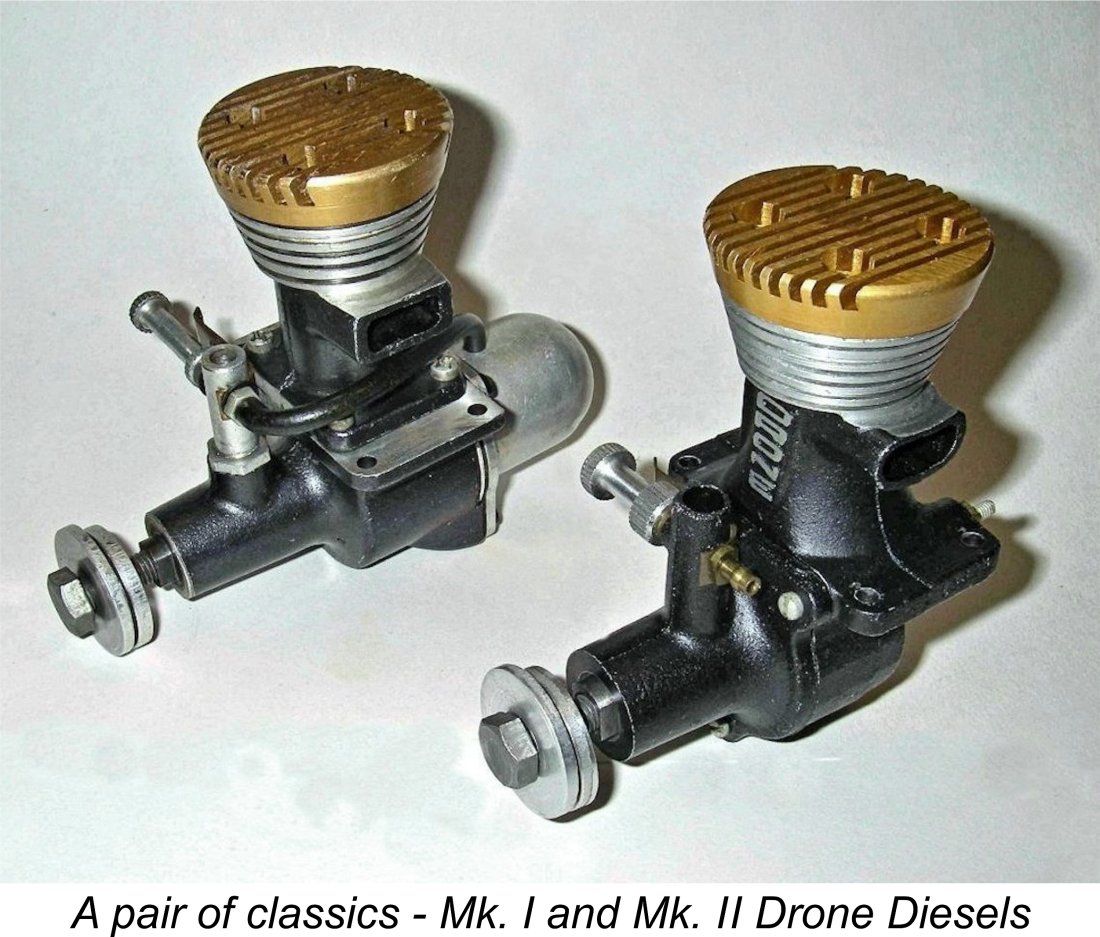 My subject this time is another of my beloved diesel engines, but one with a difference - in fact, several differences! For one thing, it was made in America, a country which produced relatively few diesel designs of any note. For another, it retained fixed compression at a time when variable compression was fast becoming the accepted standard among model diesel engine designers. Finally, it was manufactured to the very highest standards and achieved a contest record which was second to none during its relatively short production lifetime.
My subject this time is another of my beloved diesel engines, but one with a difference - in fact, several differences! For one thing, it was made in America, a country which produced relatively few diesel designs of any note. For another, it retained fixed compression at a time when variable compression was fast becoming the accepted standard among model diesel engine designers. Finally, it was manufactured to the very highest standards and achieved a contest record which was second to none during its relatively short production lifetime.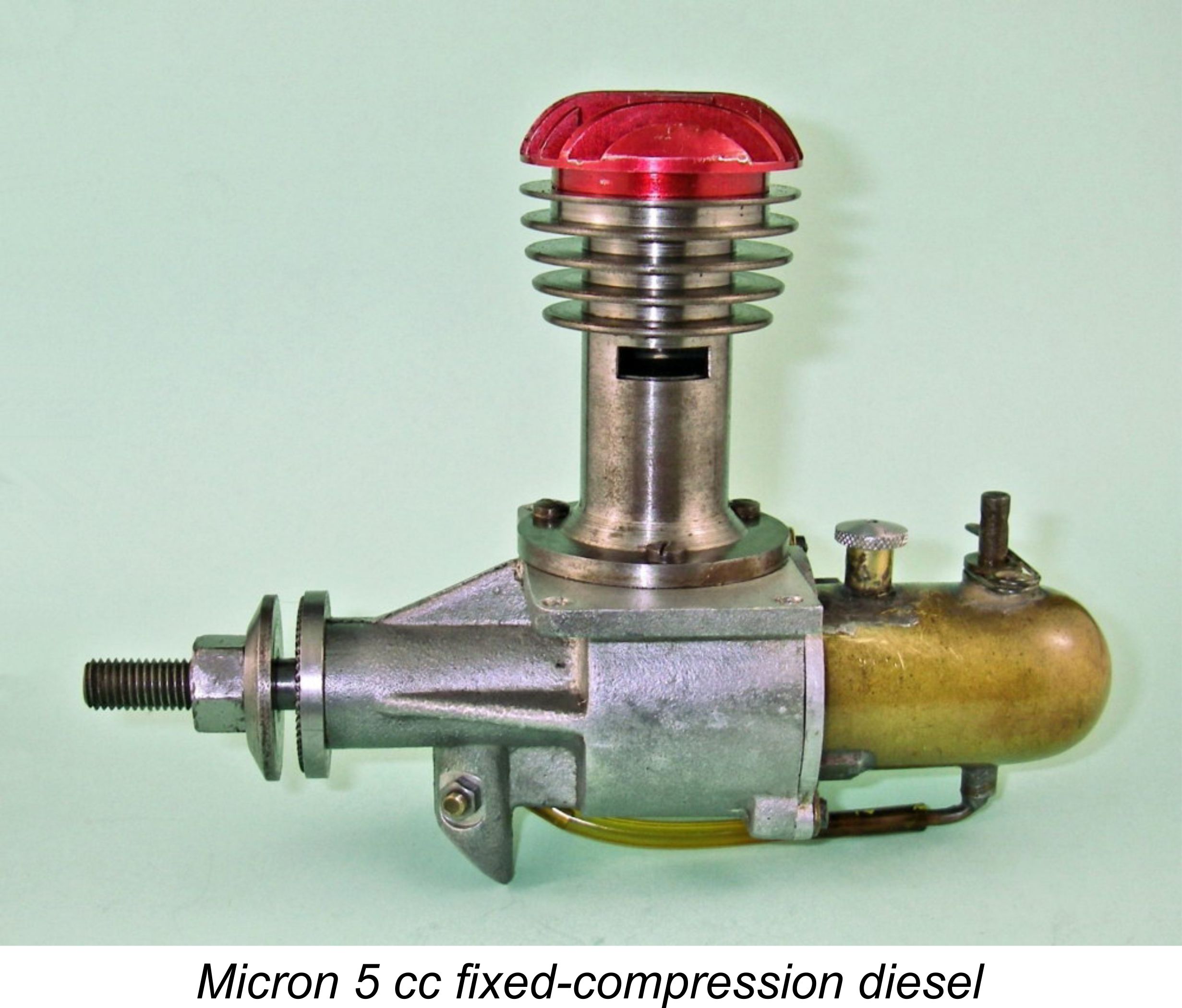 As of the mid 1940's, spark ignition engines remained dominant in American aeromodelling - the model compression ignition (“diesel”) technology which had been evolving in Europe since the late 1930’s was pretty much unknown. However, this began to change shortly after the mid 1945 conclusion of WW2 when returning US servicemen started bringing European diesels back home with them in increasing numbers.
As of the mid 1940's, spark ignition engines remained dominant in American aeromodelling - the model compression ignition (“diesel”) technology which had been evolving in Europe since the late 1930’s was pretty much unknown. However, this began to change shortly after the mid 1945 conclusion of WW2 when returning US servicemen started bringing European diesels back home with them in increasing numbers. 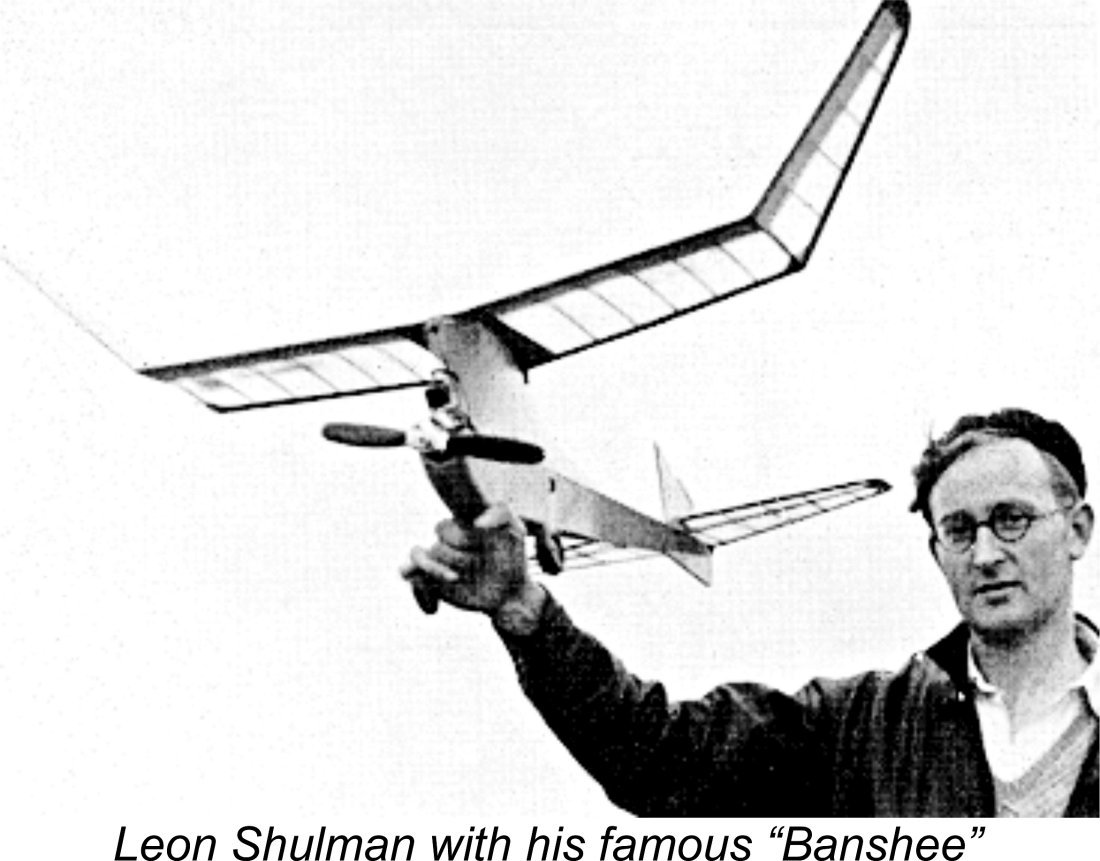 industry in 1940 at the age of only 20, when he developed and marketed a folding prop for gas models. In 1941 he followed this up by marketing an "unbreakable" plastic prop. In addition, a number of his free flight model designs such as the
industry in 1940 at the age of only 20, when he developed and marketed a folding prop for gas models. In 1941 he followed this up by marketing an "unbreakable" plastic prop. In addition, a number of his free flight model designs such as the 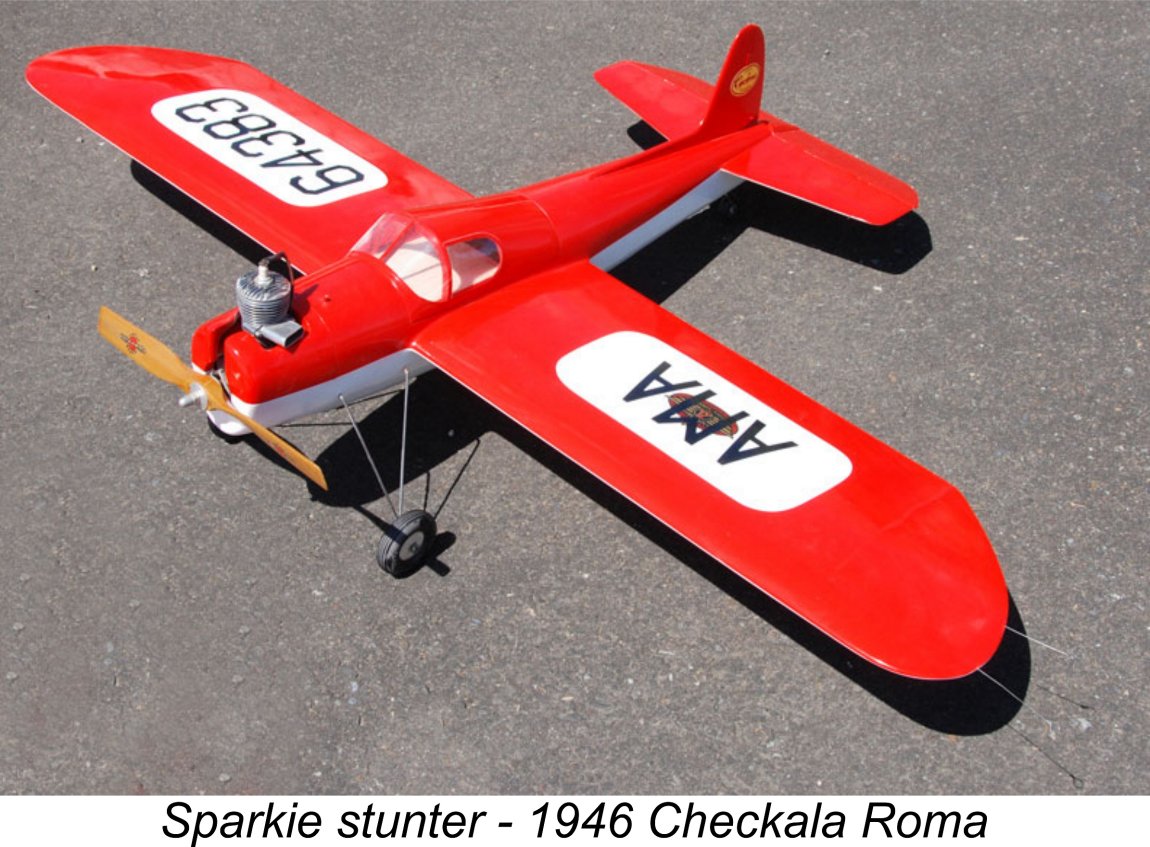 Viewed in a 1946 context (well over a full year prior to the commercial advent of the glow-plug), the two big attractions of the diesel engine for control-line use were the elimination of the dead weight represented by the spark ignition system and the dependability of the engine during both starting and running. It's easy to forget today that prior to the widespread adoption of control-line flying, engines had generally been required to make no more than 20-30 second runs in the free flight models in which they were normally employed. The advent of control-line meant that repeated runs of up to 10 minutes duration were now routinely required, and this was taxing the capabilities of many of the spark ignition engines then in use. Battery depletion, point fouling and vibration-induced electrical gremlins all militated against reliability in such service. By contrast, once running at the correct settings, the diesel would continue to run indefinitely as long as it was supplied with fuel because there was basically nothing to go wrong!
Viewed in a 1946 context (well over a full year prior to the commercial advent of the glow-plug), the two big attractions of the diesel engine for control-line use were the elimination of the dead weight represented by the spark ignition system and the dependability of the engine during both starting and running. It's easy to forget today that prior to the widespread adoption of control-line flying, engines had generally been required to make no more than 20-30 second runs in the free flight models in which they were normally employed. The advent of control-line meant that repeated runs of up to 10 minutes duration were now routinely required, and this was taxing the capabilities of many of the spark ignition engines then in use. Battery depletion, point fouling and vibration-induced electrical gremlins all militated against reliability in such service. By contrast, once running at the correct settings, the diesel would continue to run indefinitely as long as it was supplied with fuel because there was basically nothing to go wrong!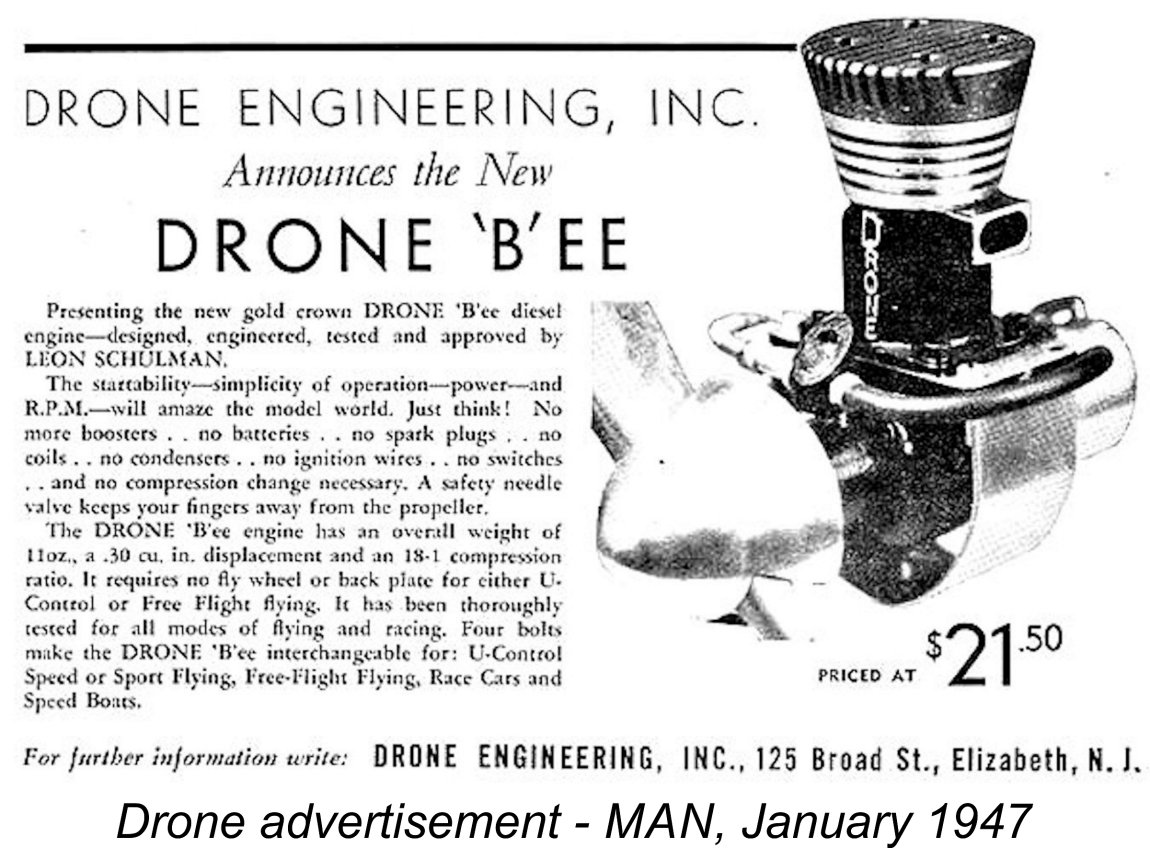 Leon Shulman's initial design concept for the Drone followed the general layout of the Micron pretty closely, in functional terms at least. However, the original prototypes of the engine differed significantly from the final production version, featuring a cast-in-place upright front intake with angled point of entry as well as the word "Drone" cast onto the front of the cylinder barrel. The prop driver was also noticeably different, as was the needle valve with its flexible extension.
Leon Shulman's initial design concept for the Drone followed the general layout of the Micron pretty closely, in functional terms at least. However, the original prototypes of the engine differed significantly from the final production version, featuring a cast-in-place upright front intake with angled point of entry as well as the word "Drone" cast onto the front of the cylinder barrel. The prop driver was also noticeably different, as was the needle valve with its flexible extension. 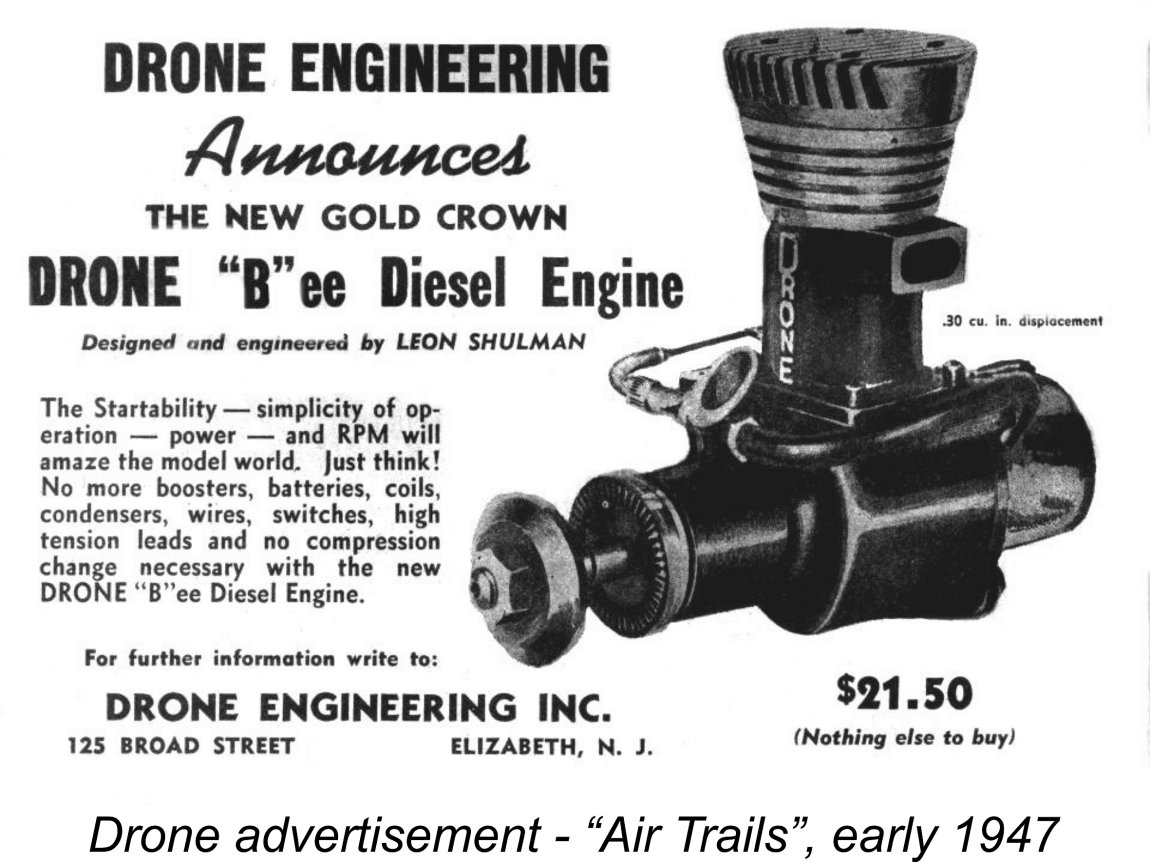 It’s a little odd that the advertisements placed in the two magazines were significantly different. The January 1947 placement in MAN showed the engine fitted with a spinner, while that in “Air Trails” showed it from a slightly different perspective with a conventional prop nut assembly. The texts of the two advertisements were also very different. One wonders why the same ad was not placed in both magazines for reasons of economy …………..regardless, by April 1947 the advertisements featured the engine in its more familiar form.
It’s a little odd that the advertisements placed in the two magazines were significantly different. The January 1947 placement in MAN showed the engine fitted with a spinner, while that in “Air Trails” showed it from a slightly different perspective with a conventional prop nut assembly. The texts of the two advertisements were also very different. One wonders why the same ad was not placed in both magazines for reasons of economy …………..regardless, by April 1947 the advertisements featured the engine in its more familiar form.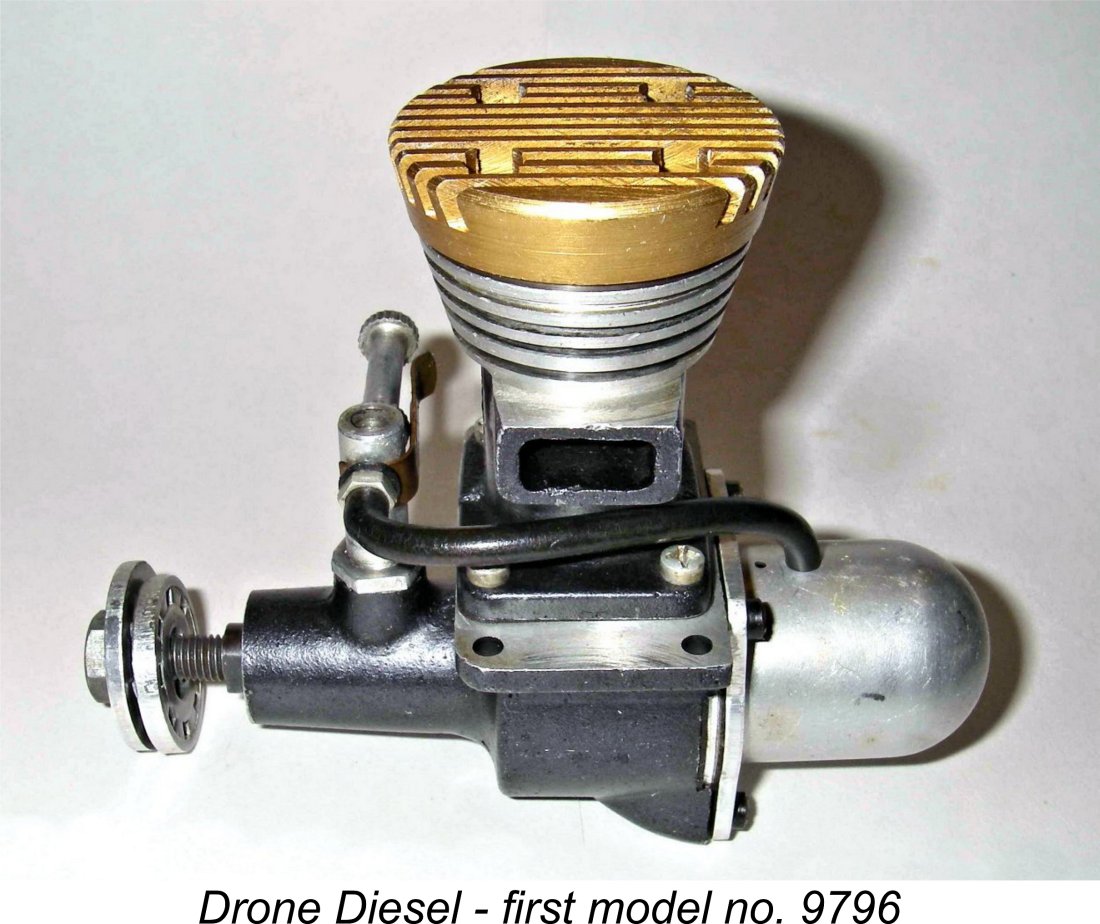 The design that finally reached the marketplace in early 1947 is generally referred to as the first model Drone, or the Drone plain-bearing model if you prefer. It was basically similar to the design illustrated in the early advertisements, but the cast-on word "Drone" was moved from the front of the bolt-on cylinder barrel casting to the bypass bulge opposite the exhaust. In addition, the original cast-in-unit venturi was replaced by a separate screw-in item which could be positioned to set the needle in any desired orientation using a lock-nut. The needle valve was changed from the flexible arrangement seen on the prototypes to a long solid light alloy thimble having a flat leaf spring "clicker" for tension. Finally, the design of the prop driver was amended.
The design that finally reached the marketplace in early 1947 is generally referred to as the first model Drone, or the Drone plain-bearing model if you prefer. It was basically similar to the design illustrated in the early advertisements, but the cast-on word "Drone" was moved from the front of the bolt-on cylinder barrel casting to the bypass bulge opposite the exhaust. In addition, the original cast-in-unit venturi was replaced by a separate screw-in item which could be positioned to set the needle in any desired orientation using a lock-nut. The needle valve was changed from the flexible arrangement seen on the prototypes to a long solid light alloy thimble having a flat leaf spring "clicker" for tension. Finally, the design of the prop driver was amended.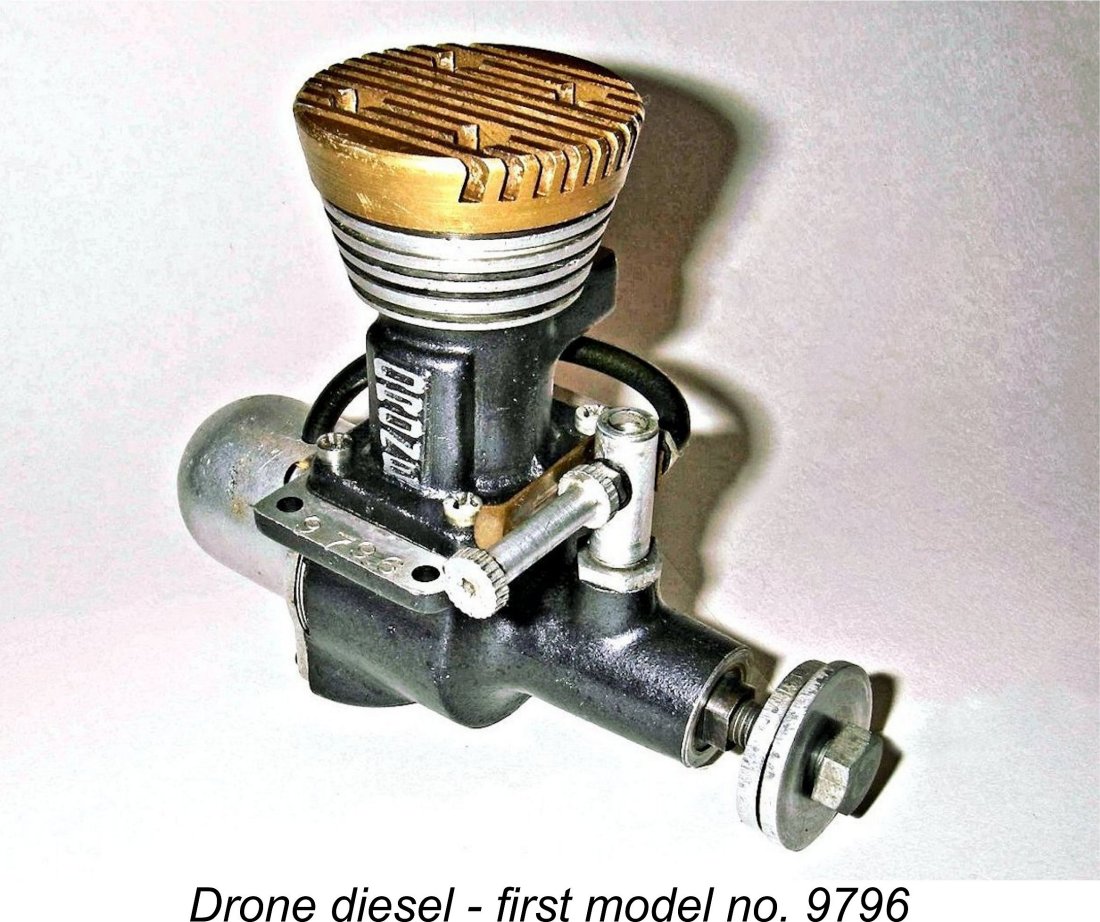 The main crankcase casting incorporated the main bearing in unit, with a separate cylinder casting being attached to the top of the case with four screws. This cylinder casting incorporated the exhaust stack, the bypass passage and the machined cooling fins. The steel cylinder liner was a simple drop-in item which was retained by the gold-anodized head. The head in turn was secured by four screws and sealed to the liner with one or more gaskets. The fixed geometric compression ratio could be adjusted between runs by adding or removing head gaskets as required. It's only a fixed compression engine if you allow it to be!
The main crankcase casting incorporated the main bearing in unit, with a separate cylinder casting being attached to the top of the case with four screws. This cylinder casting incorporated the exhaust stack, the bypass passage and the machined cooling fins. The steel cylinder liner was a simple drop-in item which was retained by the gold-anodized head. The head in turn was secured by four screws and sealed to the liner with one or more gaskets. The fixed geometric compression ratio could be adjusted between runs by adding or removing head gaskets as required. It's only a fixed compression engine if you allow it to be!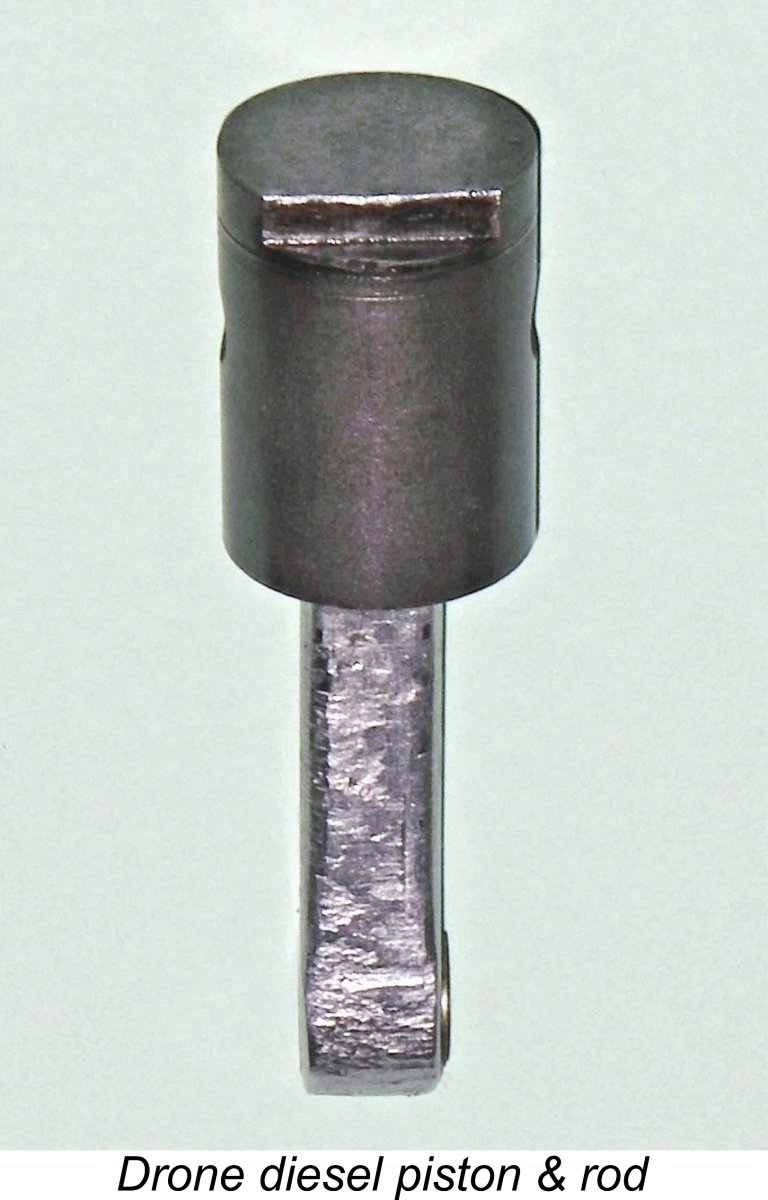 The cast iron piston was stepped on the transfer side much like that of the Micron. It was carried on a sturdy forged alloy rod with a bronze bushing in the big end. The steel gudgeon pin was equipped with flat brass end-pads. These are not infrequently missing in present-day examples that have been disassembled and re-assembled by less-than-careful owners, making this a point well worth checking before you try to run one of these engines. No sense scoring a good bore!
The cast iron piston was stepped on the transfer side much like that of the Micron. It was carried on a sturdy forged alloy rod with a bronze bushing in the big end. The steel gudgeon pin was equipped with flat brass end-pads. These are not infrequently missing in present-day examples that have been disassembled and re-assembled by less-than-careful owners, making this a point well worth checking before you try to run one of these engines. No sense scoring a good bore!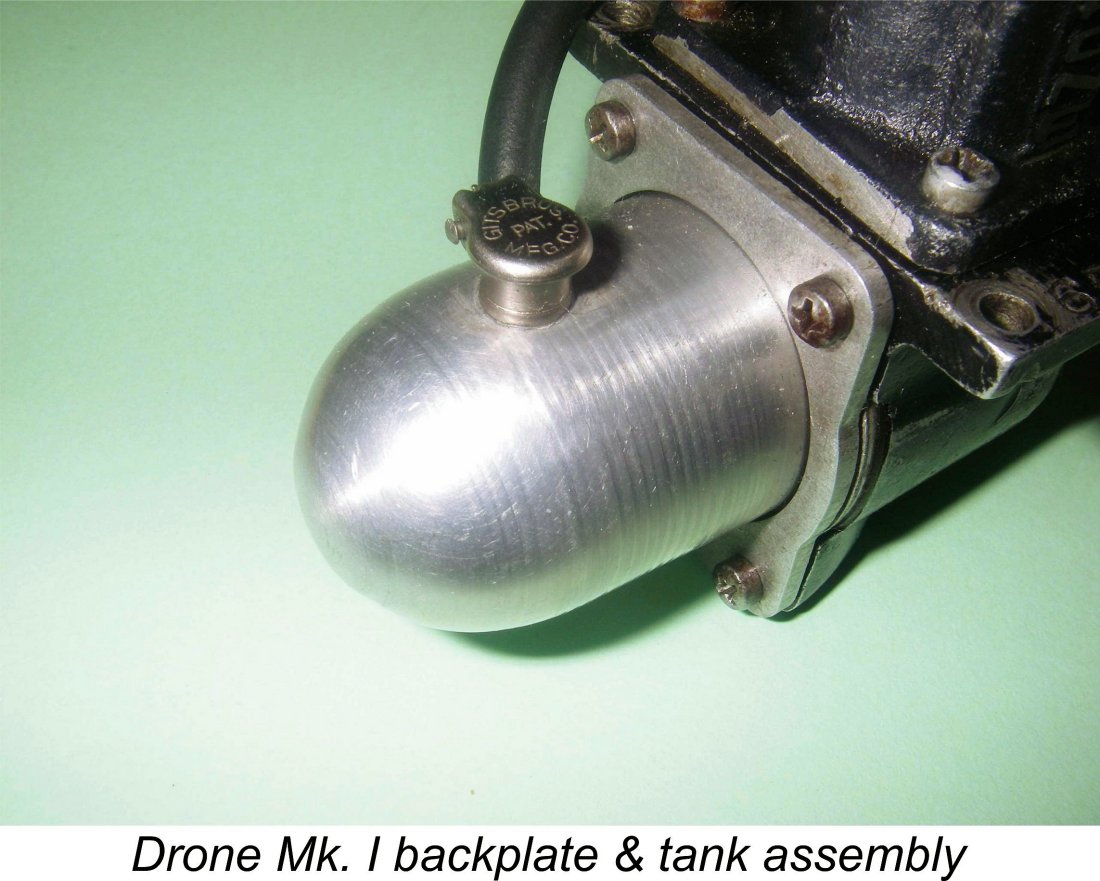 Unusually, the backplate was a light alloy stamping which was installed in a rather distinctive manner. The unthreaded backplate simply plugged directly into the case with a thick perimeter gasket for a seal. The tank had a flange which bore against the rear of the backplate rim, again sealing with a gasket. The entire assembly was held in place by a flat plate retainer of light alloy which incorporated a large hole for the spun aluminium tank and was secured by four screws at the corners. This retainer bore upon the rear face of the tank flange to "clamp" the entire assembly with the two gaskets in a compressed state for good sealing of both tank and case. It was neither necessary nor desirable to over-tighten the screws to achieve a good seal - doing so merely bent the corners of the retaining plate. If it was desired to run the engine without the tank, one simply removed the flat plate retainer, removed the Gits cap, discarded the tank and replaced the retainer.
Unusually, the backplate was a light alloy stamping which was installed in a rather distinctive manner. The unthreaded backplate simply plugged directly into the case with a thick perimeter gasket for a seal. The tank had a flange which bore against the rear of the backplate rim, again sealing with a gasket. The entire assembly was held in place by a flat plate retainer of light alloy which incorporated a large hole for the spun aluminium tank and was secured by four screws at the corners. This retainer bore upon the rear face of the tank flange to "clamp" the entire assembly with the two gaskets in a compressed state for good sealing of both tank and case. It was neither necessary nor desirable to over-tighten the screws to achieve a good seal - doing so merely bent the corners of the retaining plate. If it was desired to run the engine without the tank, one simply removed the flat plate retainer, removed the Gits cap, discarded the tank and replaced the retainer.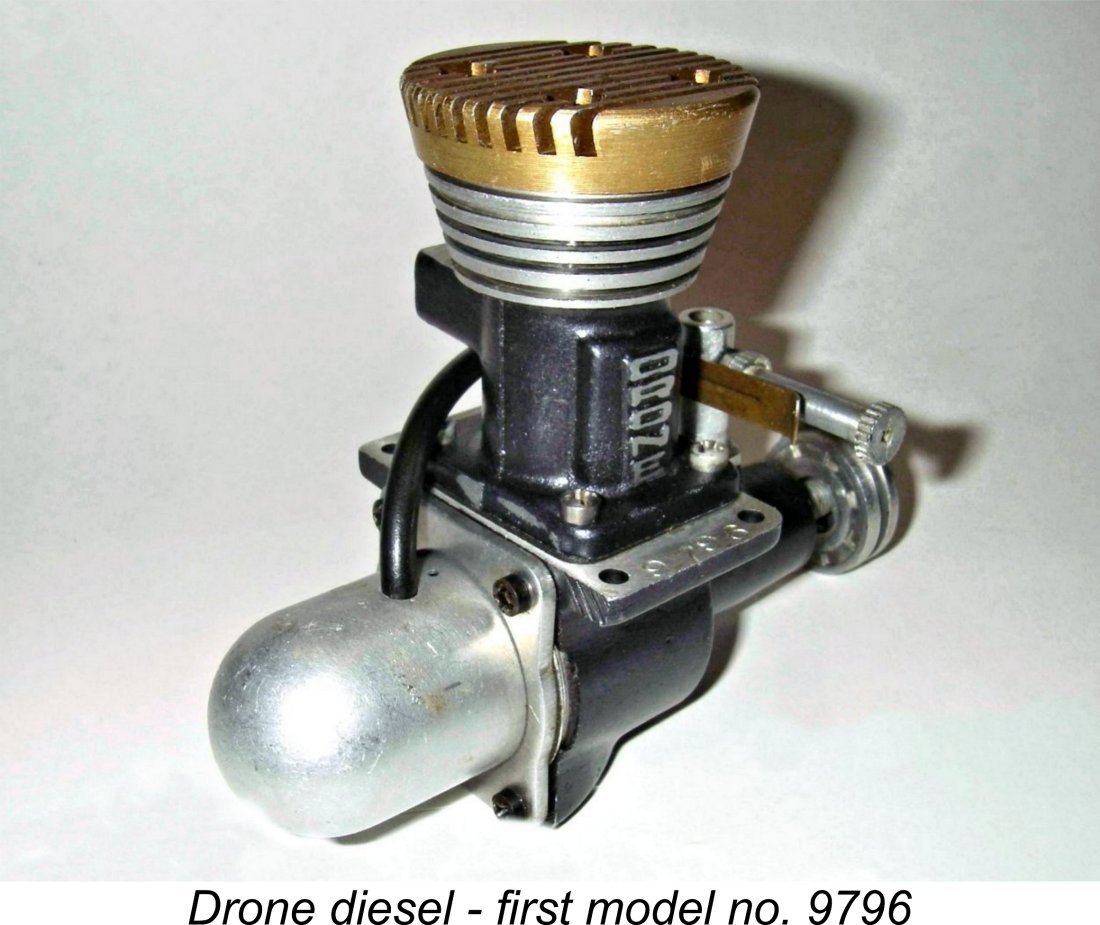 Most tanks such as that illustrated above had a Gits cap on the filler hole, but a few of the later models lacked this fitting - the engine which appears in most of the attached illustrations is a NIB example of one of these late models (s/n 9796). Either they ran out of Gits caps shortly before they ran out of tanks, or they realized that most users would discard the tank anyway, which required the removal of the Gits cap to clear the retaining plate. Once again, there was no point in re-ordering since the Gits caps were not required for the tankless second model Drone which was soon to replace the first model.
Most tanks such as that illustrated above had a Gits cap on the filler hole, but a few of the later models lacked this fitting - the engine which appears in most of the attached illustrations is a NIB example of one of these late models (s/n 9796). Either they ran out of Gits caps shortly before they ran out of tanks, or they realized that most users would discard the tank anyway, which required the removal of the Gits cap to clear the retaining plate. Once again, there was no point in re-ordering since the Gits caps were not required for the tankless second model Drone which was soon to replace the first model.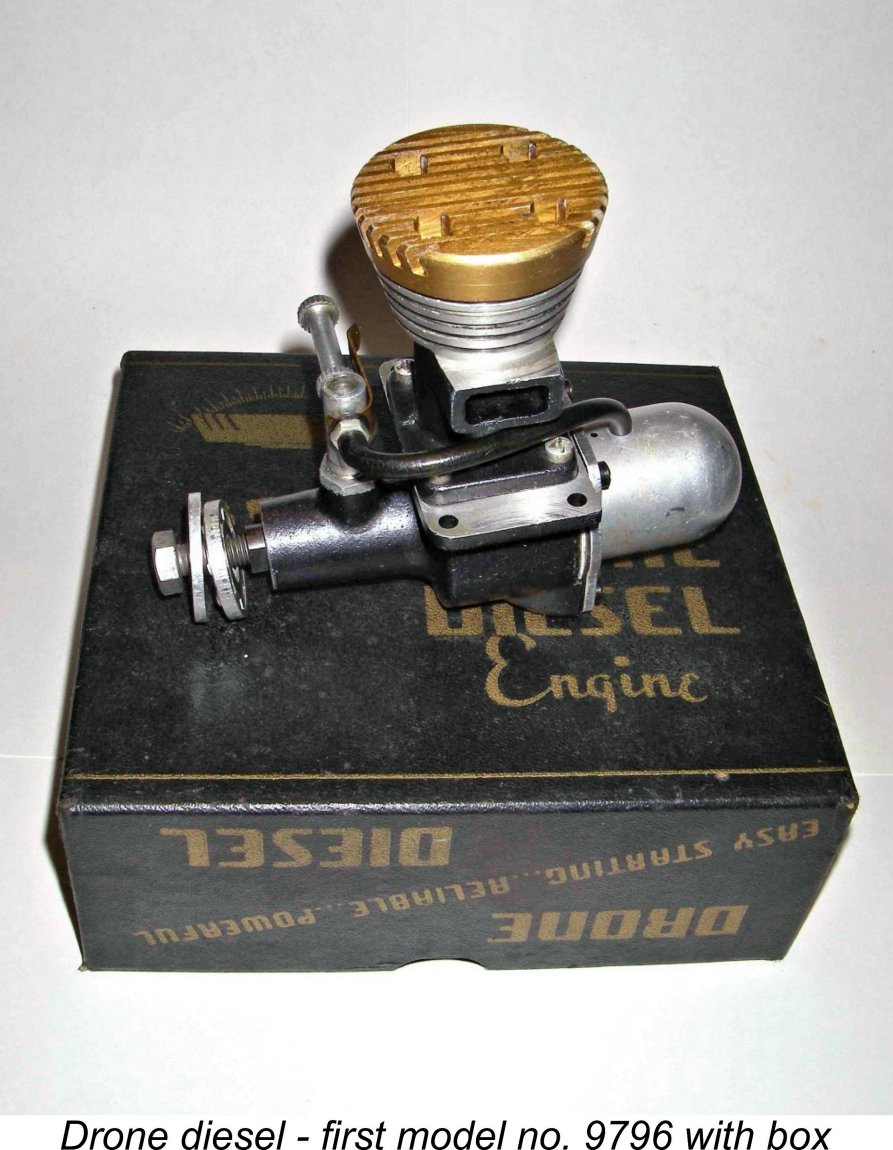 Drone Engineering who had been responsible for fitting the piston/cylinder units for the Drone engines. He recalled using Bon Ami to produce the ultimate fit between the two components. If the typically excellent fits on surviving Drones are anything to go by, he was a real craftsman!
Drone Engineering who had been responsible for fitting the piston/cylinder units for the Drone engines. He recalled using Bon Ami to produce the ultimate fit between the two components. If the typically excellent fits on surviving Drones are anything to go by, he was a real craftsman!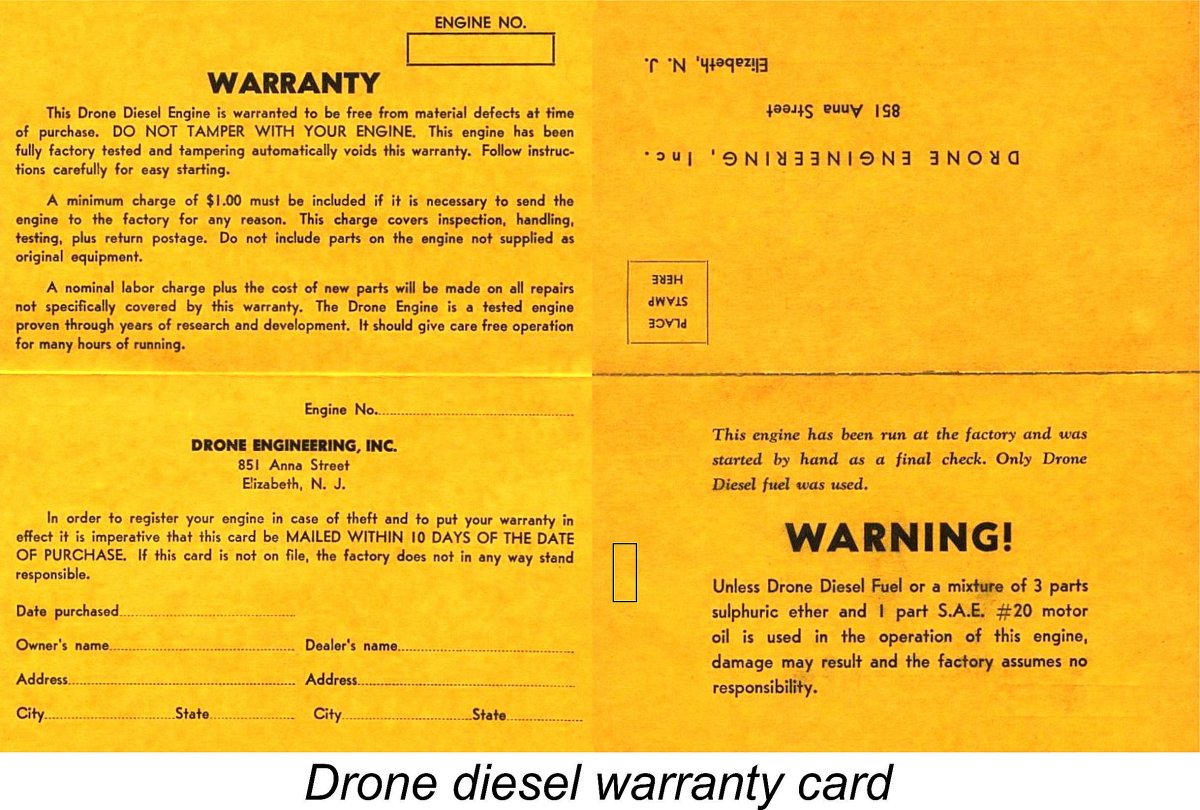
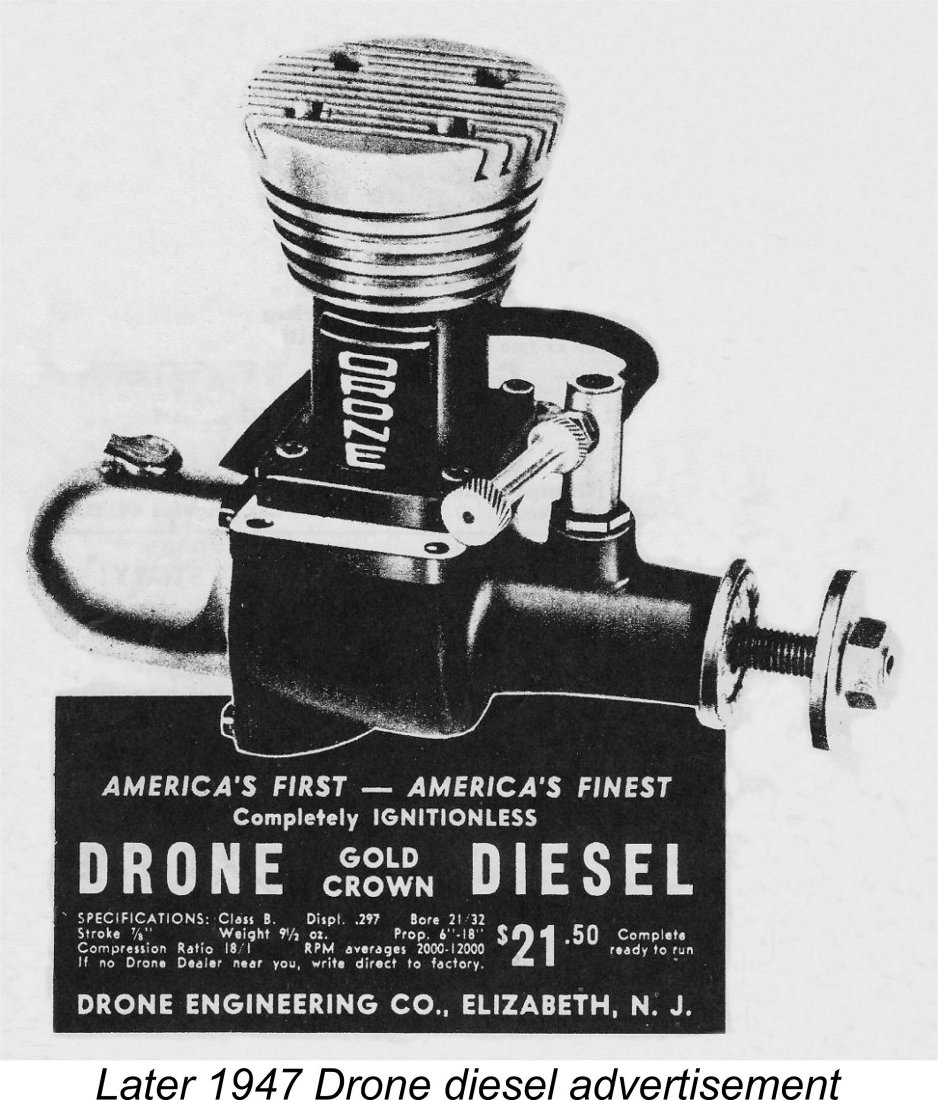 The lack of long-term warranty protection meant that if the engine performed OK out of the box but developed a problem later on, claiming on the guarantee might be a bit of a challenge!! However, there's a great deal of logic in the above wording - any manufacturer's primary obligation to the customer is surely to supply an item that is fully capable of performing as the customer expects, and that's what Drone Engineering were specifically guaranteeing. Moreover, they claimed to have established this fact through a hands-on test of the engine, so they were on pretty firm ground if challenged. What happened down the road was out of the maker's control, hence the absence of any guarantee beyond the original condition of the engine. In particular, they did not feel responsible for any user-related problems! Perhaps they knew their customers ………….or at least some of them!
The lack of long-term warranty protection meant that if the engine performed OK out of the box but developed a problem later on, claiming on the guarantee might be a bit of a challenge!! However, there's a great deal of logic in the above wording - any manufacturer's primary obligation to the customer is surely to supply an item that is fully capable of performing as the customer expects, and that's what Drone Engineering were specifically guaranteeing. Moreover, they claimed to have established this fact through a hands-on test of the engine, so they were on pretty firm ground if challenged. What happened down the road was out of the maker's control, hence the absence of any guarantee beyond the original condition of the engine. In particular, they did not feel responsible for any user-related problems! Perhaps they knew their customers ………….or at least some of them! 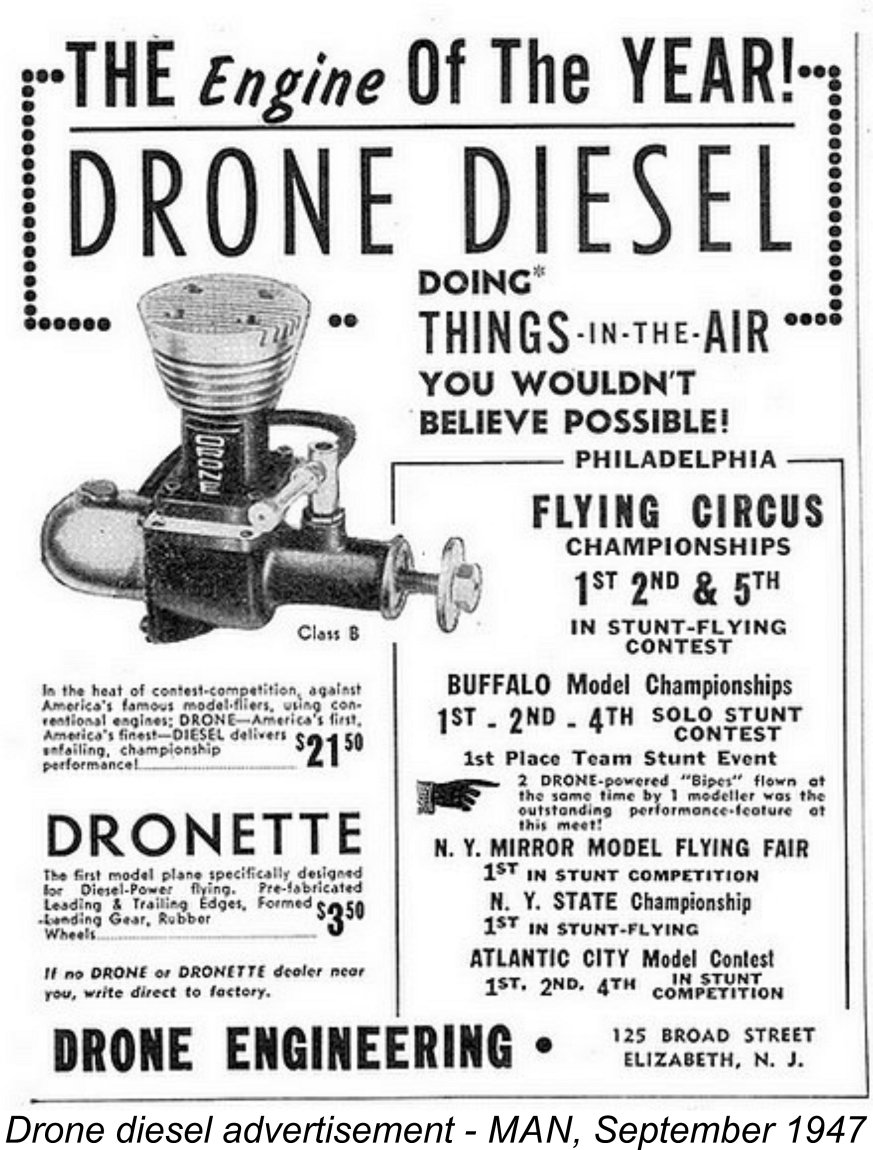
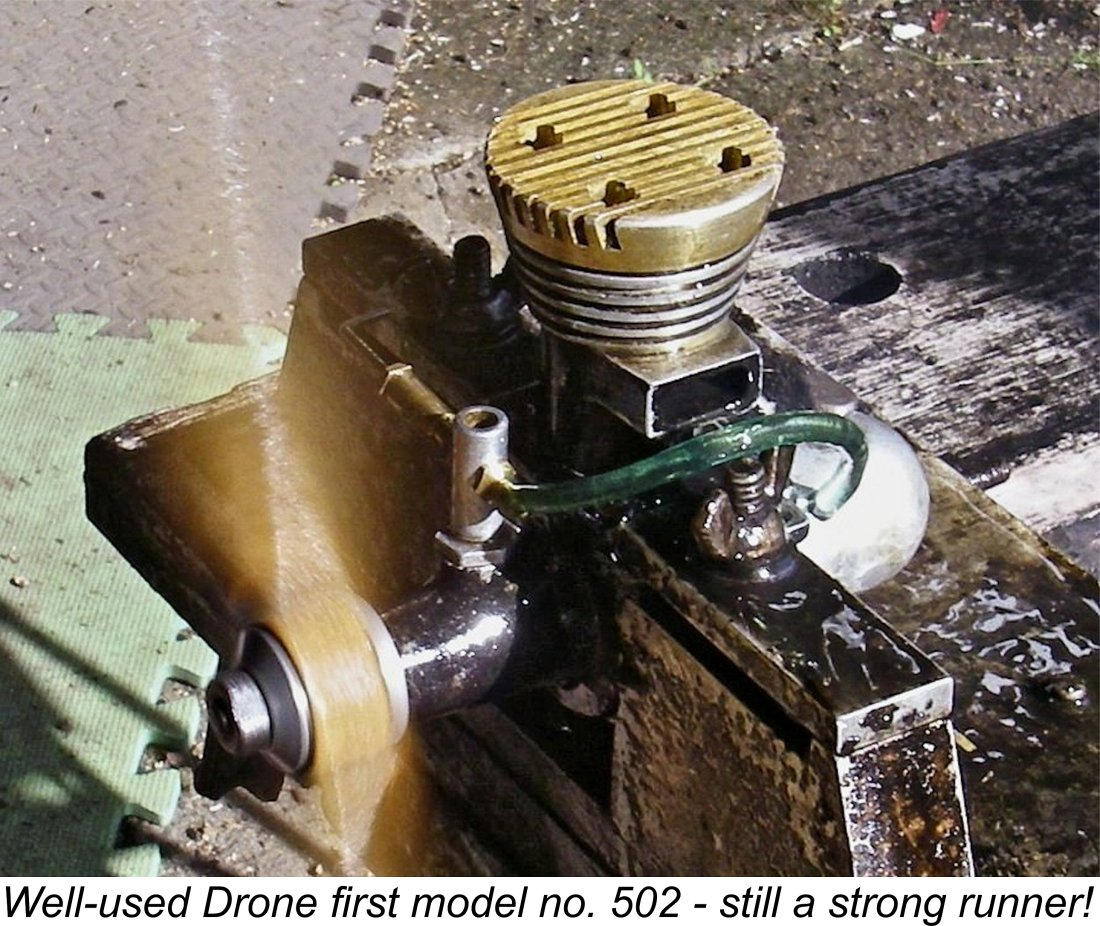 In hindsight, the problem likely arose from the fact that the fuel tank arrangements used at the time were such that part of every run in a model was unavoidably spent in a lean-running condition, and lean running of the Drone was accompanied by a considerable amount of detonation of the rather volatile ether fuel, as we shall see later. This detonation clearly gave rise to internal shock loadings which the best of bearings could not absorb forever. In addition, there is a suspicion that a higher percentage of slightly heavier oil might have done a better job of protecting the bearing. I usually run my first model Drones on 30% oil of SAE 30 viscosity.
In hindsight, the problem likely arose from the fact that the fuel tank arrangements used at the time were such that part of every run in a model was unavoidably spent in a lean-running condition, and lean running of the Drone was accompanied by a considerable amount of detonation of the rather volatile ether fuel, as we shall see later. This detonation clearly gave rise to internal shock loadings which the best of bearings could not absorb forever. In addition, there is a suspicion that a higher percentage of slightly heavier oil might have done a better job of protecting the bearing. I usually run my first model Drones on 30% oil of SAE 30 viscosity.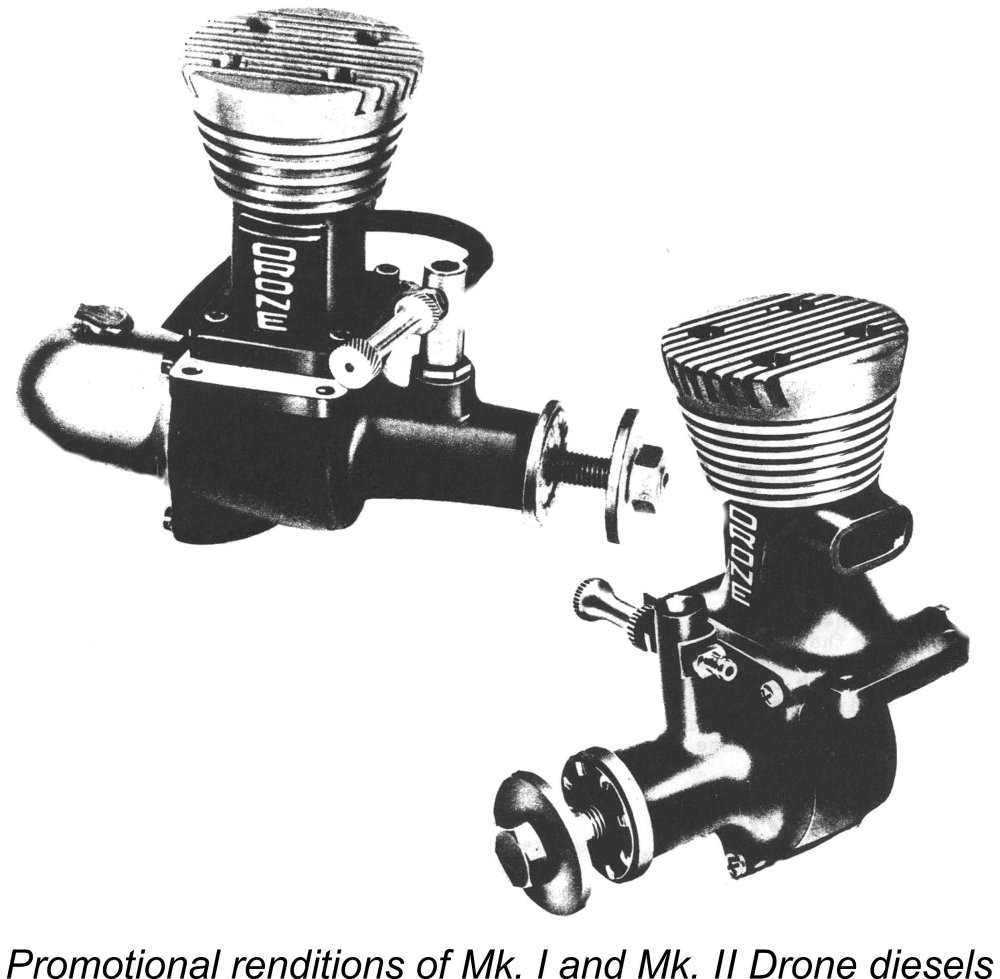 The second model Drone, often referred to as the ball-bearing Drone, was very far from being a minor revision of the first model. As can be seen from the attached promotional views of the two designs, it was in fact an all-new production throughout. Difficult though it may be to believe, the only interchangeable part between the two models was the prop washer!
The second model Drone, often referred to as the ball-bearing Drone, was very far from being a minor revision of the first model. As can be seen from the attached promotional views of the two designs, it was in fact an all-new production throughout. Difficult though it may be to believe, the only interchangeable part between the two models was the prop washer!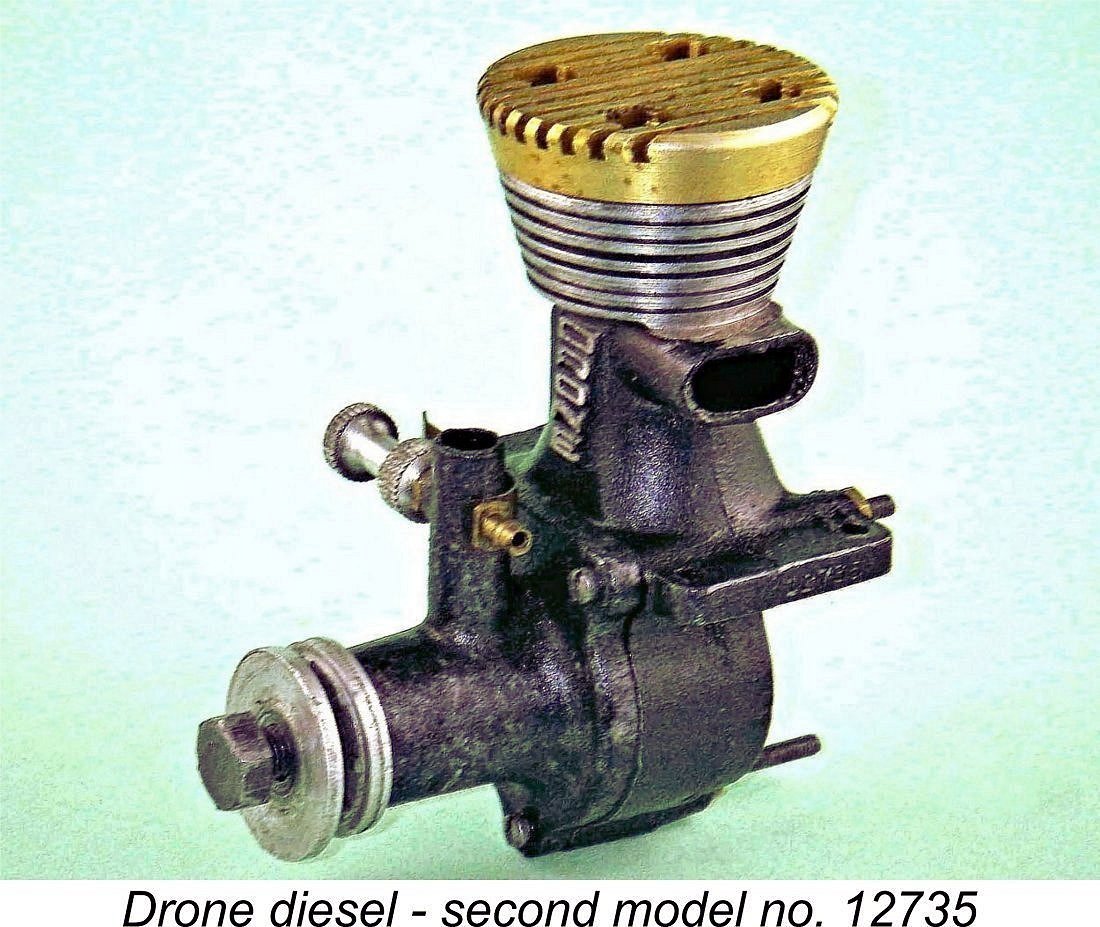 The crankshaft journal diameter was unchanged from that used on the first model Drone, but the induction port was now a simple round hole. This gave slightly slower opening and closing of the induction system but was probably an improvement in terms of strength and was certainly simpler from a production standpoint. Given the engine's relatively low operating speed, the slightly less responsive induction system was probably not an issue in any case.
The crankshaft journal diameter was unchanged from that used on the first model Drone, but the induction port was now a simple round hole. This gave slightly slower opening and closing of the induction system but was probably an improvement in terms of strength and was certainly simpler from a production standpoint. Given the engine's relatively low operating speed, the slightly less responsive induction system was probably not an issue in any case.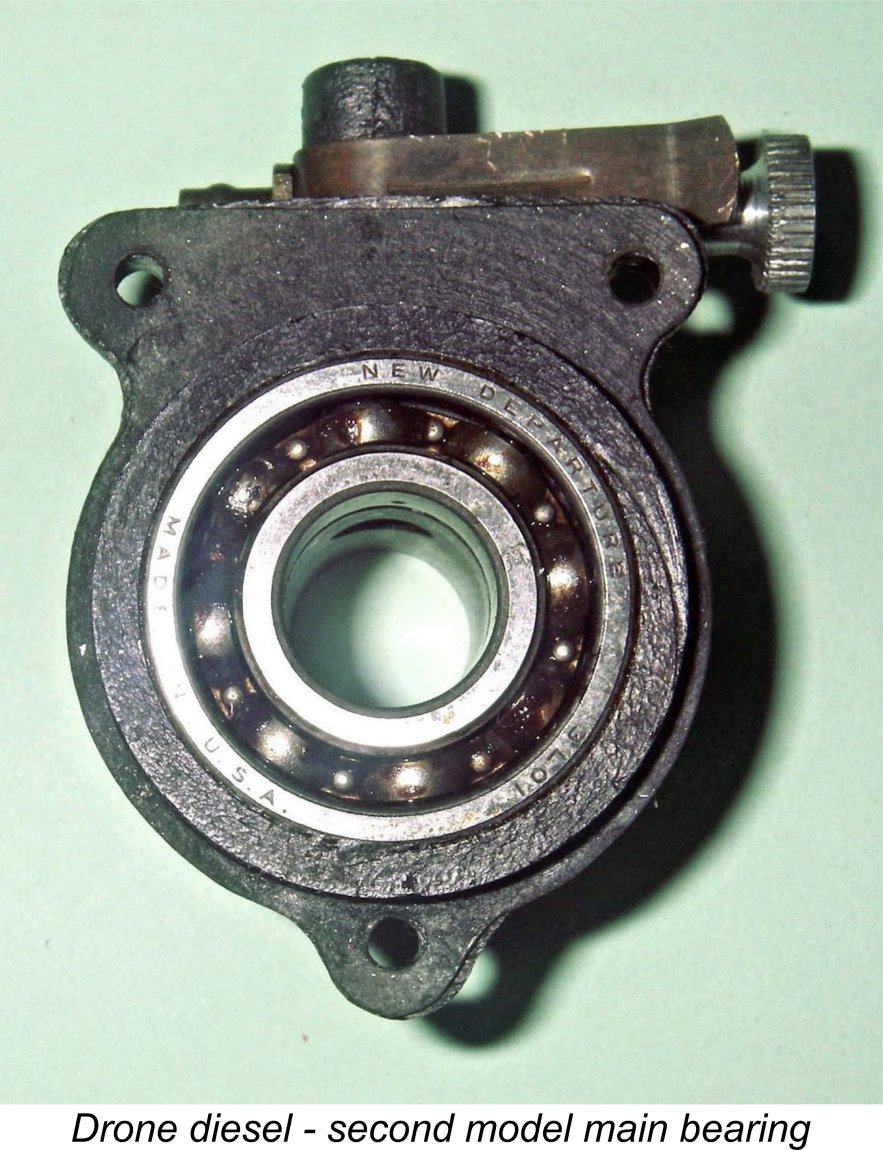 The most significant design change was the incorporation of a single ball race at the rear of the main bearing. It might be thought that this was done to reduce bearing friction, thus allowing a higher operating speed. Although this was doubtless a factor, the change was almost certainly motivated primarily by a desire to extend engine life through the elimination of the problem of excessive radial wear at the heavily-loaded rear of the main bearing. In this respect, the change was extremely effective. The balance of the main bearing, which was of course far less heavily loaded, was left plain - even the bronze bushing was omitted.
The most significant design change was the incorporation of a single ball race at the rear of the main bearing. It might be thought that this was done to reduce bearing friction, thus allowing a higher operating speed. Although this was doubtless a factor, the change was almost certainly motivated primarily by a desire to extend engine life through the elimination of the problem of excessive radial wear at the heavily-loaded rear of the main bearing. In this respect, the change was extremely effective. The balance of the main bearing, which was of course far less heavily loaded, was left plain - even the bronze bushing was omitted. 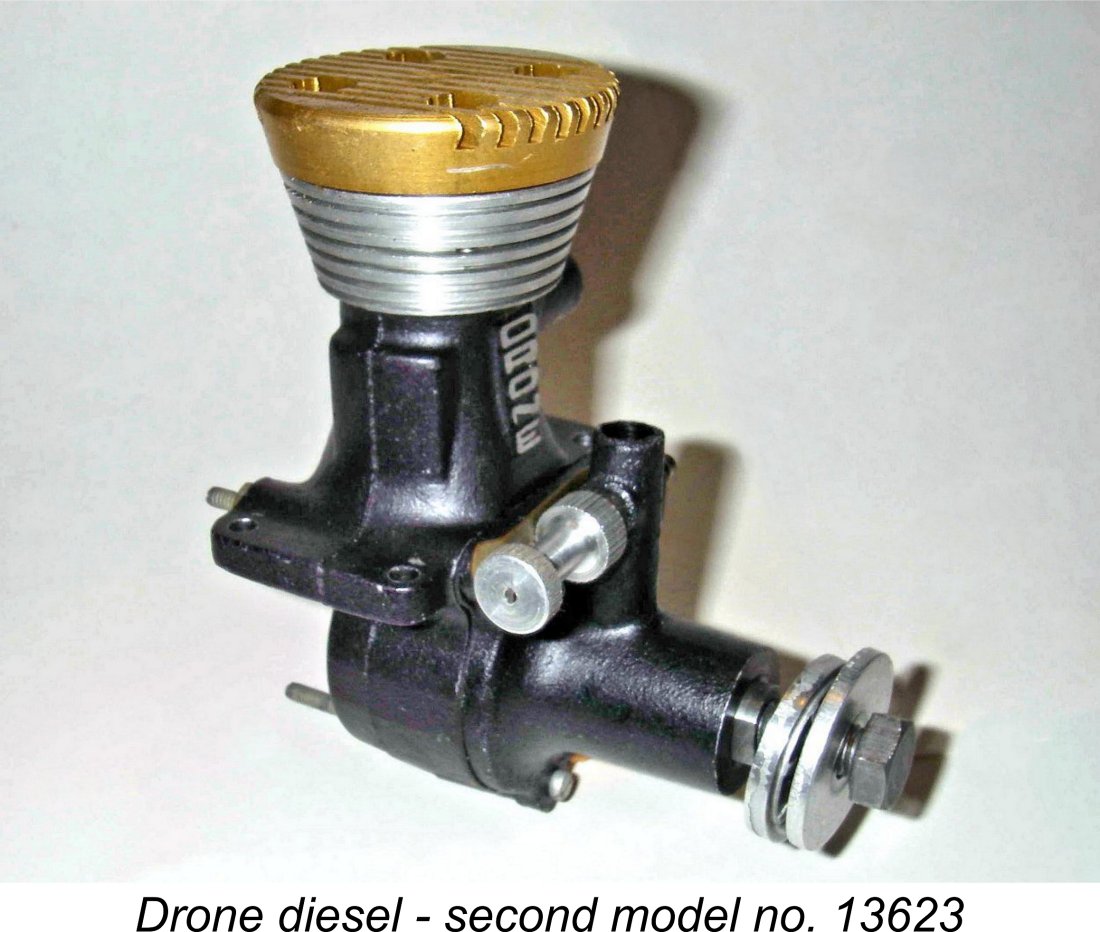 fixed compression ratio from 18:1 to 18.5:1, no doubt to bring it into line with the higher operating speeds of which the engine was now capable. However, fuel and propeller recommendations remained unchanged - the idea was to turn the same props at a higher speed.
fixed compression ratio from 18:1 to 18.5:1, no doubt to bring it into line with the higher operating speeds of which the engine was now capable. However, fuel and propeller recommendations remained unchanged - the idea was to turn the same props at a higher speed.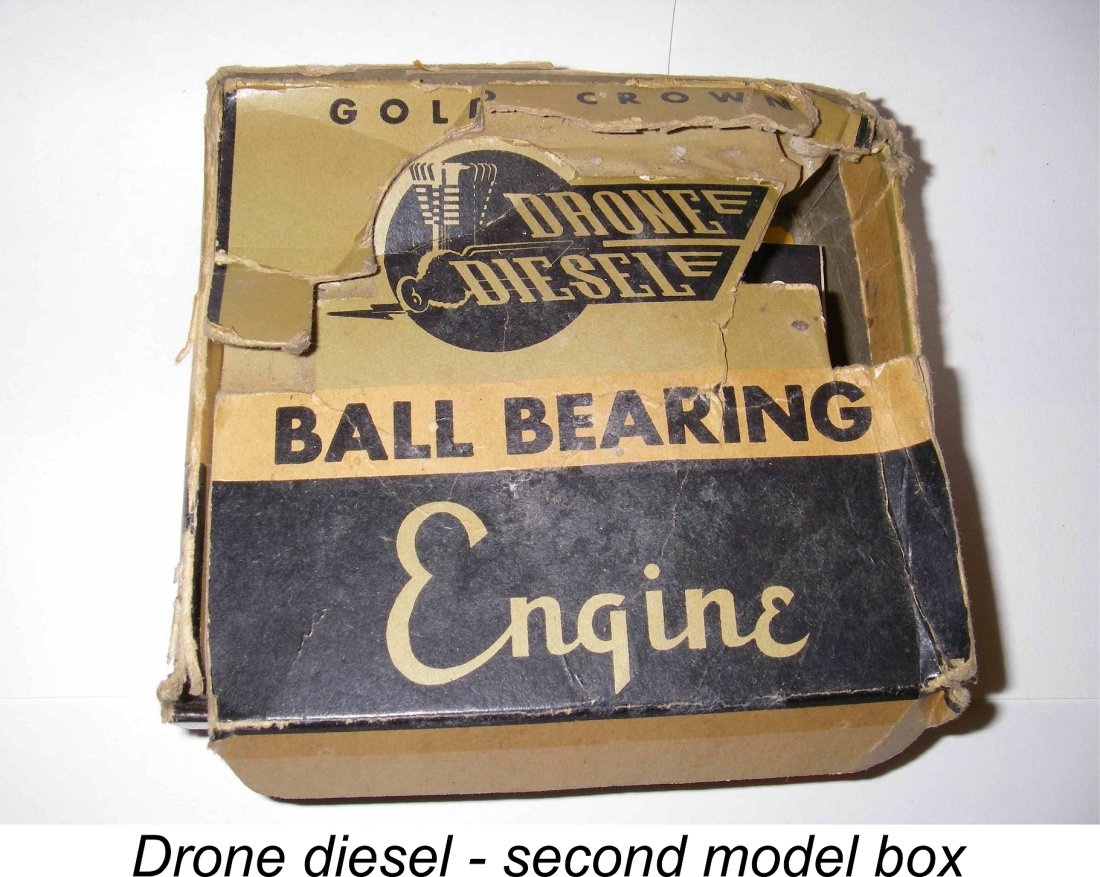 The serial numbers for this model were relocated to the outer end of the left-hand mounting lug (facing forward in the direction of flight). The numbers for the second model Drone started at around 10,000 and went up to around 15,000. All examples of my extensive past and present acquaintance are within this range.
The serial numbers for this model were relocated to the outer end of the left-hand mounting lug (facing forward in the direction of flight). The numbers for the second model Drone started at around 10,000 and went up to around 15,000. All examples of my extensive past and present acquaintance are within this range.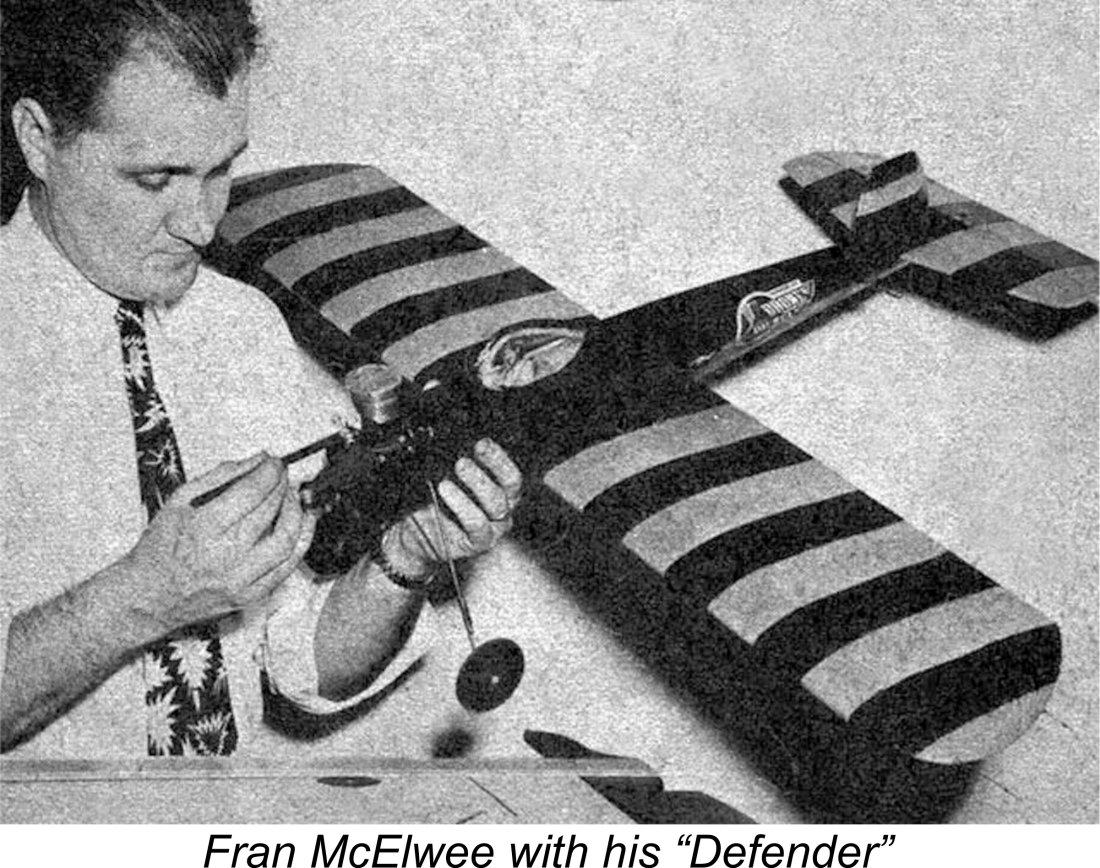
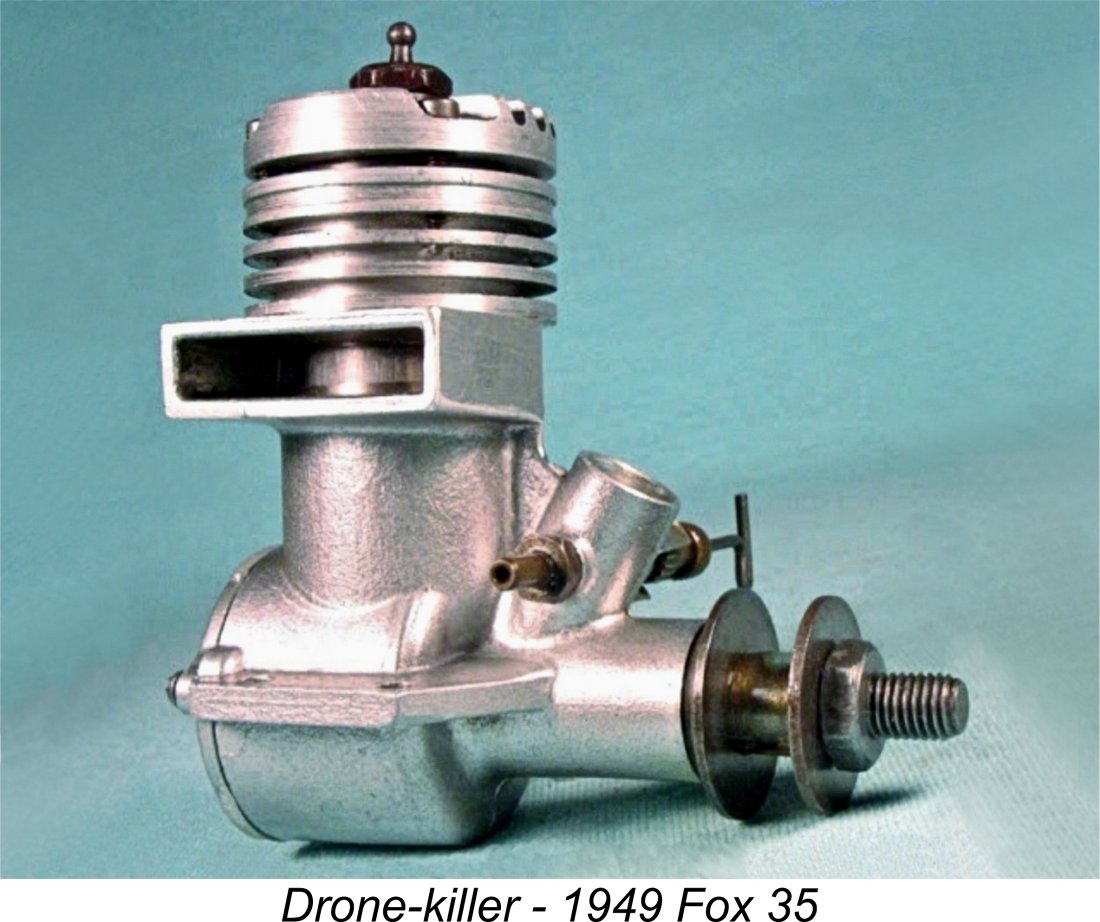 However, this happy situation was destined not to last - even while the Drone was maintaining its competition pre-eminence in 1948, a large black cloud was looming ever-larger on the horizon. The trigger was Ray Arden’s November 1947 introduction of the commercial miniature glow-plug.
However, this happy situation was destined not to last - even while the Drone was maintaining its competition pre-eminence in 1948, a large black cloud was looming ever-larger on the horizon. The trigger was Ray Arden’s November 1947 introduction of the commercial miniature glow-plug.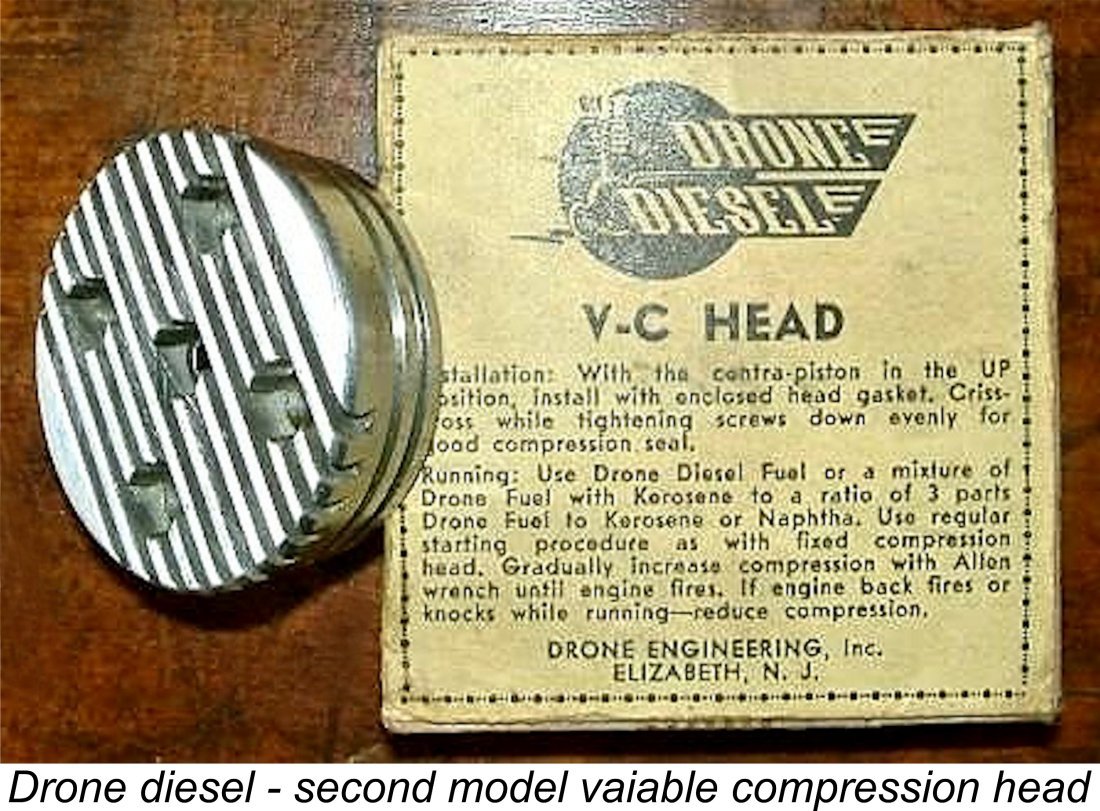
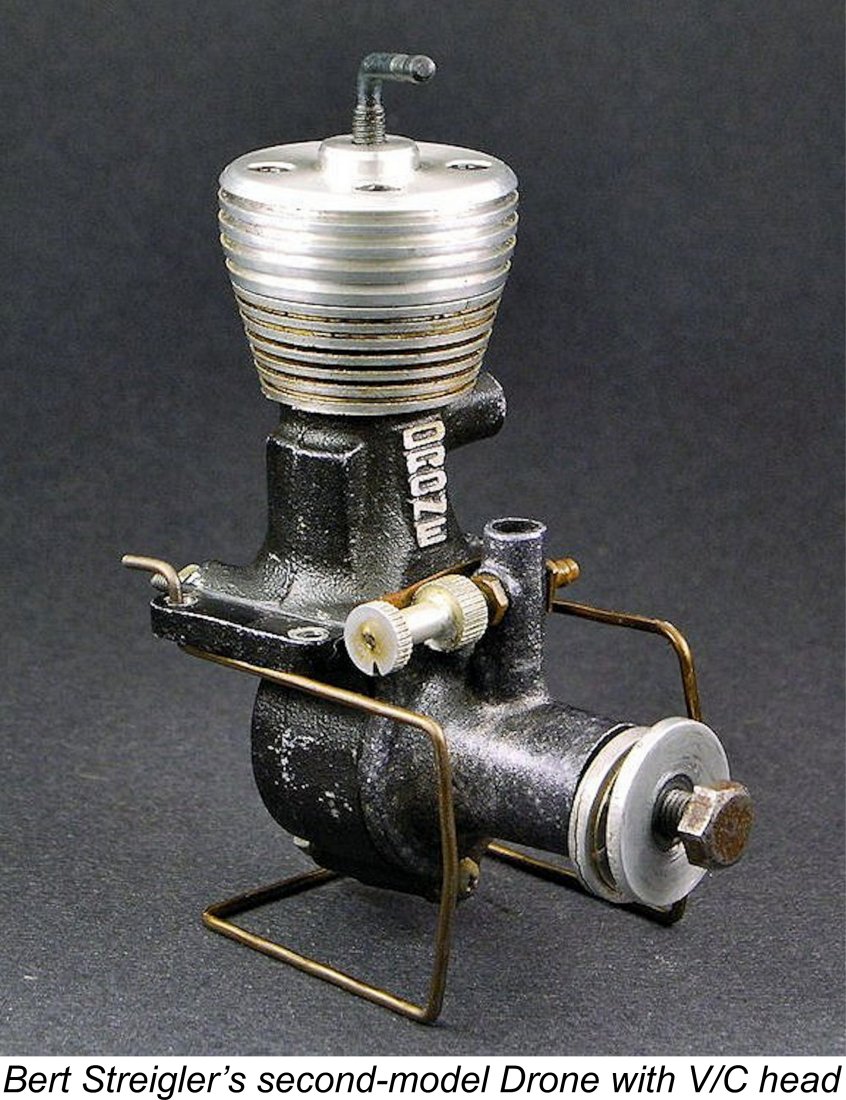
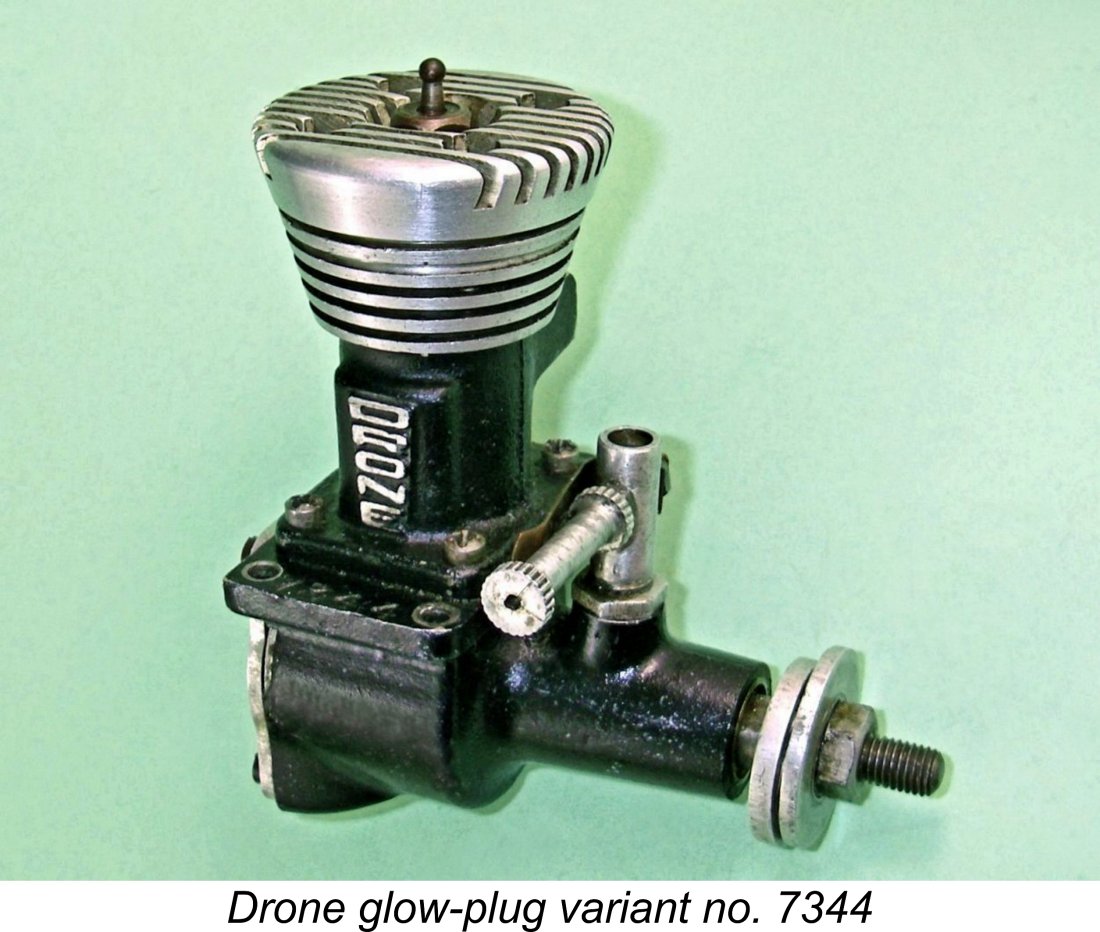 contact with his good friend Leon Shulman, the accessory glow head was only ever supplied by the factory for the 1
contact with his good friend Leon Shulman, the accessory glow head was only ever supplied by the factory for the 1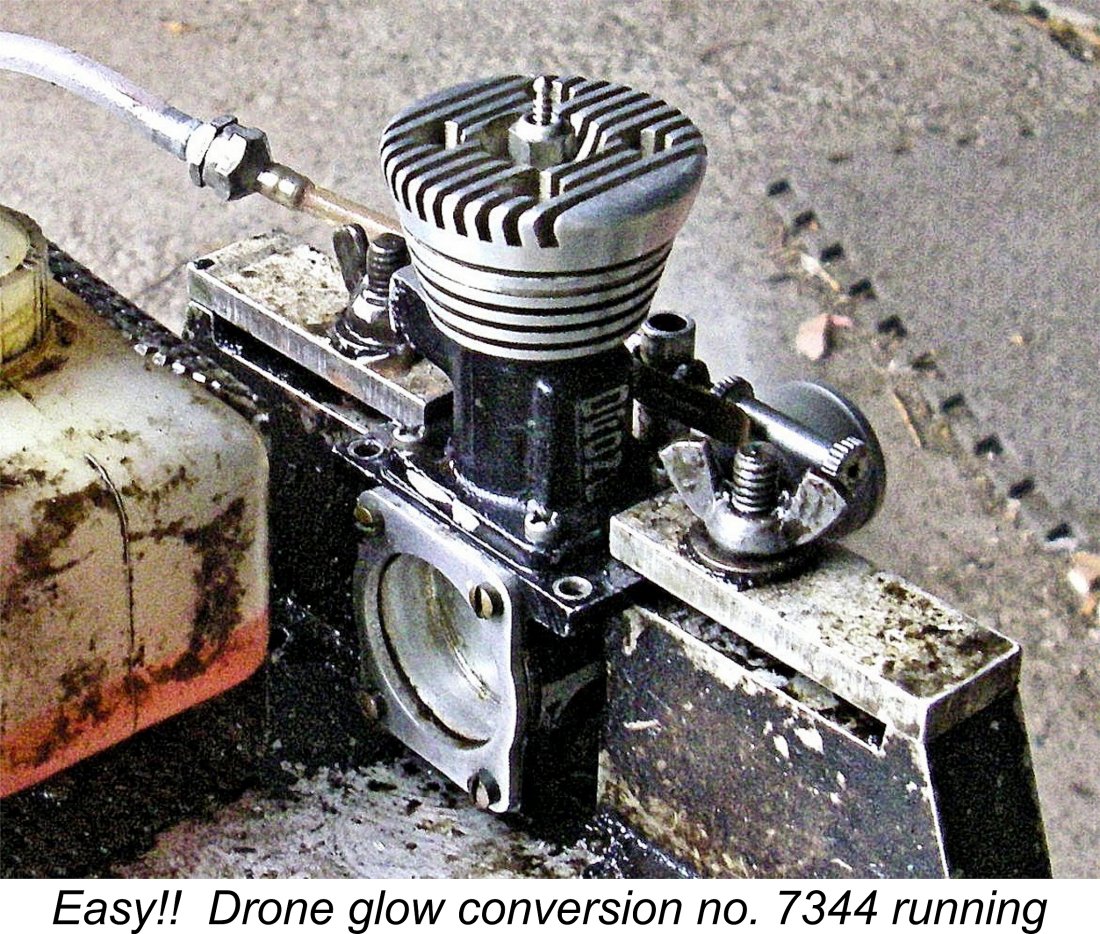 The converted heads were not anodized, being left in their plain aluminium finish to distinguish them from the diesel heads. There have been a few previous reports that such heads were also supplied in red, but Gus Munich stated categorically that this is incorrect - Leon Shulman confirmed that only the plain finish was ever supplied by the factory. Any red-anodized heads are therefore the work of later owners.
The converted heads were not anodized, being left in their plain aluminium finish to distinguish them from the diesel heads. There have been a few previous reports that such heads were also supplied in red, but Gus Munich stated categorically that this is incorrect - Leon Shulman confirmed that only the plain finish was ever supplied by the factory. Any red-anodized heads are therefore the work of later owners.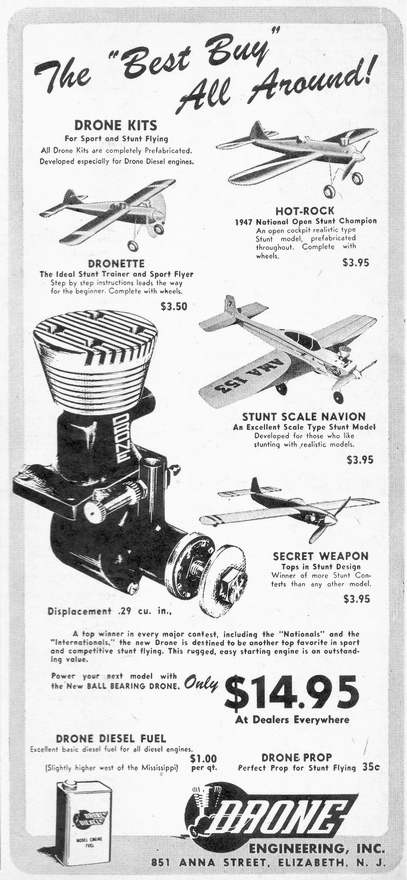 The Drone didn't die overnight following the introduction of the all-conquering Fox 35. It was after all an established winner which had swept all before it during the previous two seasons. The substantial army of dedicated Drone users had become well versed in the engine's unique operating requirements, initially sticking with what they knew. As far as they were concerned, the new type of engine had yet to prove itself.
The Drone didn't die overnight following the introduction of the all-conquering Fox 35. It was after all an established winner which had swept all before it during the previous two seasons. The substantial army of dedicated Drone users had become well versed in the engine's unique operating requirements, initially sticking with what they knew. As far as they were concerned, the new type of engine had yet to prove itself.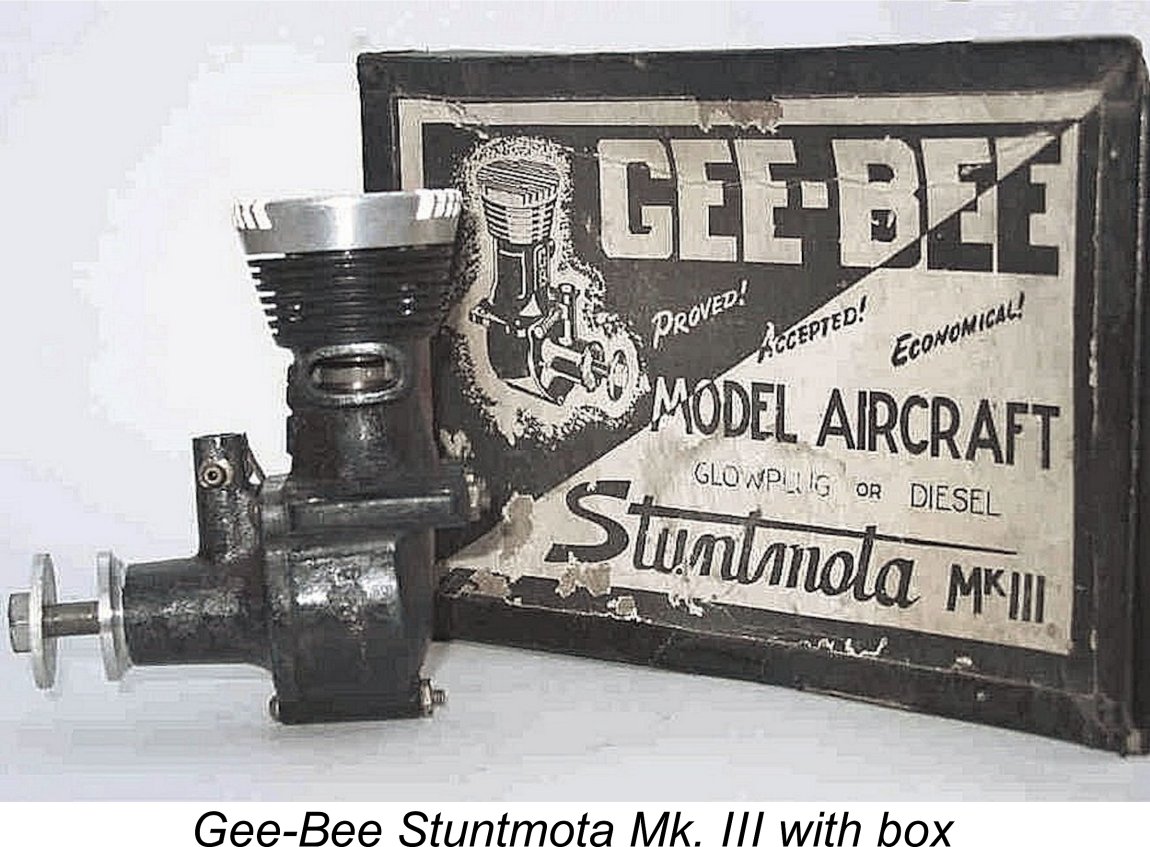 various capacities connected with the marketing side of the model industry, rising to the position of Vice-President of
various capacities connected with the marketing side of the model industry, rising to the position of Vice-President of 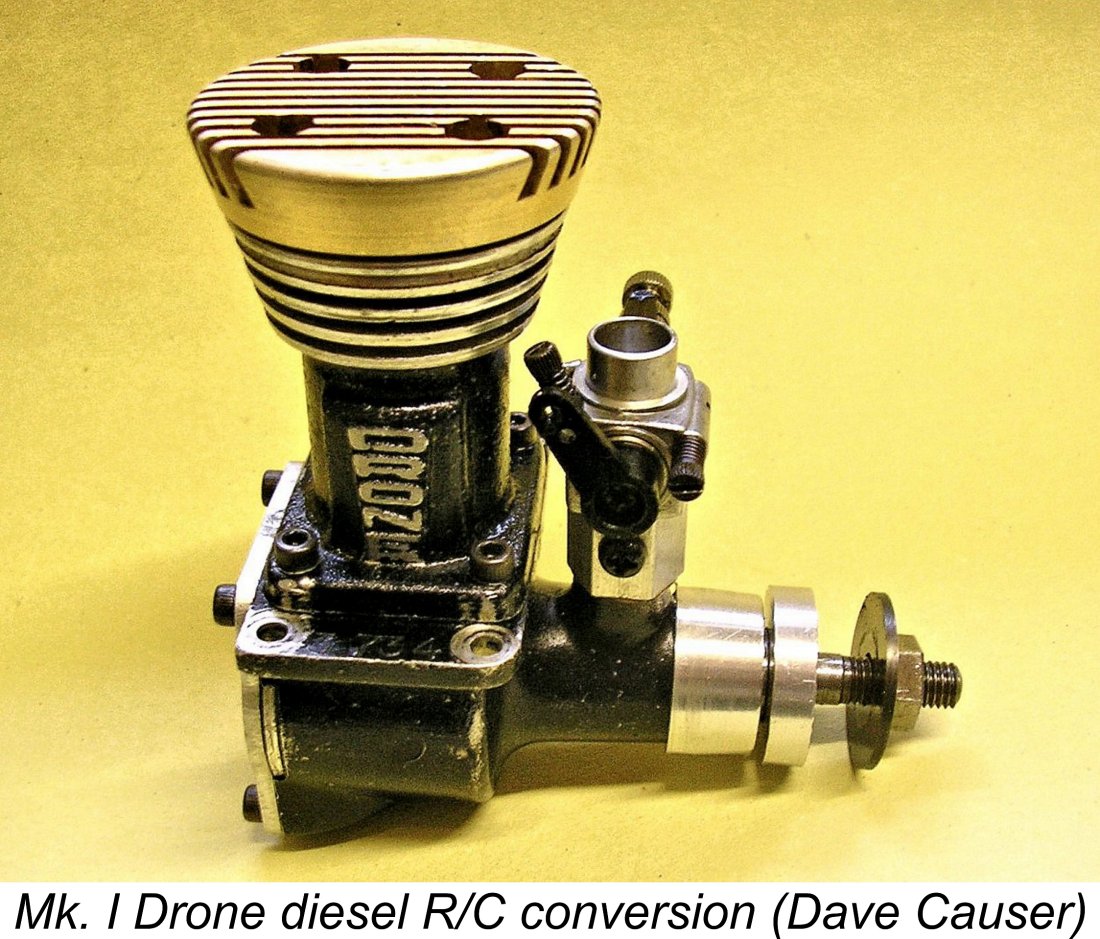
 Another claimed that it wouldn't run at all and that most buyers consequently threw them out in disgust as useless boat anchors! If that's so, why are there still so many of them in circulation today - who raided the trash bins of America? How did they win all those high-profile contests? Why, without exception, did all the reviewers rave about how good they were? And how did Leon Shulman manage to persuade 15,000 punters to buy them? Negative reputations travel fast if they're well founded, but good reputations travel faster!
Another claimed that it wouldn't run at all and that most buyers consequently threw them out in disgust as useless boat anchors! If that's so, why are there still so many of them in circulation today - who raided the trash bins of America? How did they win all those high-profile contests? Why, without exception, did all the reviewers rave about how good they were? And how did Leon Shulman manage to persuade 15,000 punters to buy them? Negative reputations travel fast if they're well founded, but good reputations travel faster!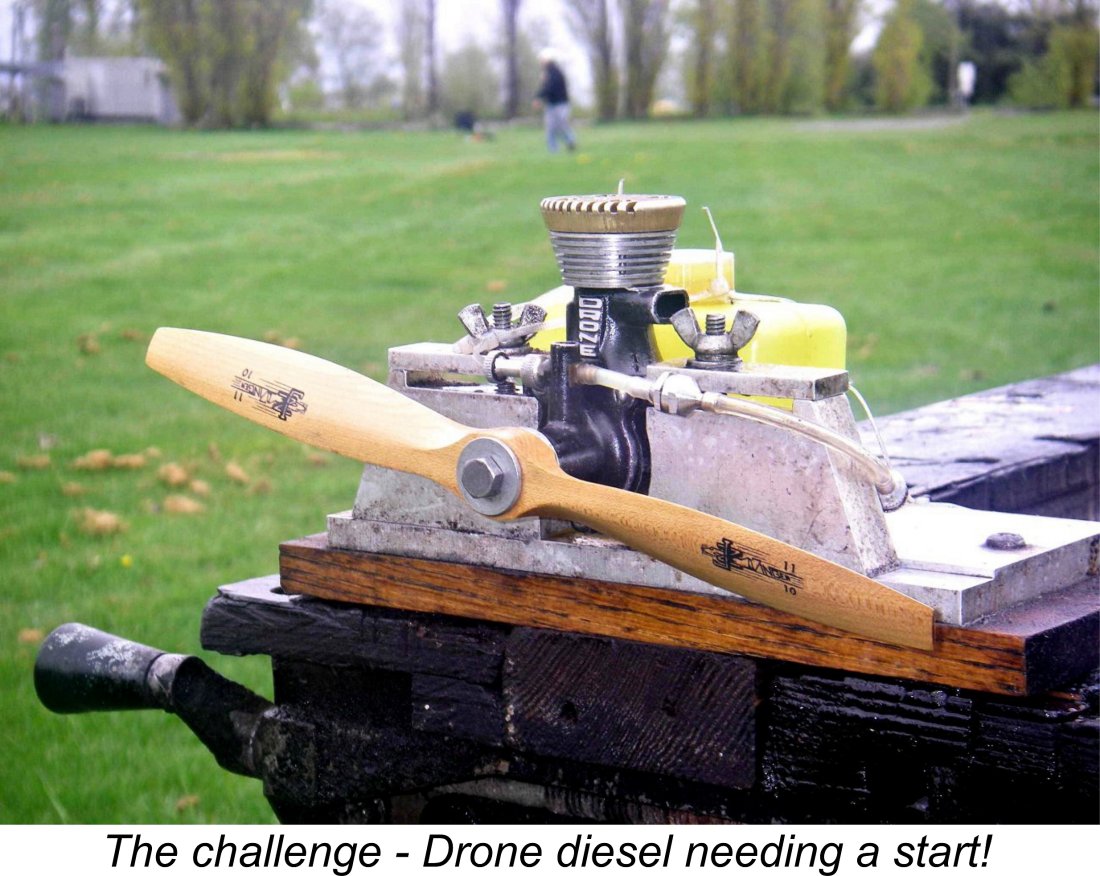 In reality, starting a Drone is almost absurdly easy if (and only if) the correct fuel and prop are used and the appropriate procedures are followed! Having owned no fewer than twelve Drones in my time and having run most of them and flown a few of them with no problems at all, I feel well qualified to say that! And I'm not alone in my assessment - long-time Drone user and fellow Drone enthusiast Gus Munich fully supported this view, as do the engine's stellar contest record and uniformly positive media reviews.
In reality, starting a Drone is almost absurdly easy if (and only if) the correct fuel and prop are used and the appropriate procedures are followed! Having owned no fewer than twelve Drones in my time and having run most of them and flown a few of them with no problems at all, I feel well qualified to say that! And I'm not alone in my assessment - long-time Drone user and fellow Drone enthusiast Gus Munich fully supported this view, as do the engine's stellar contest record and uniformly positive media reviews.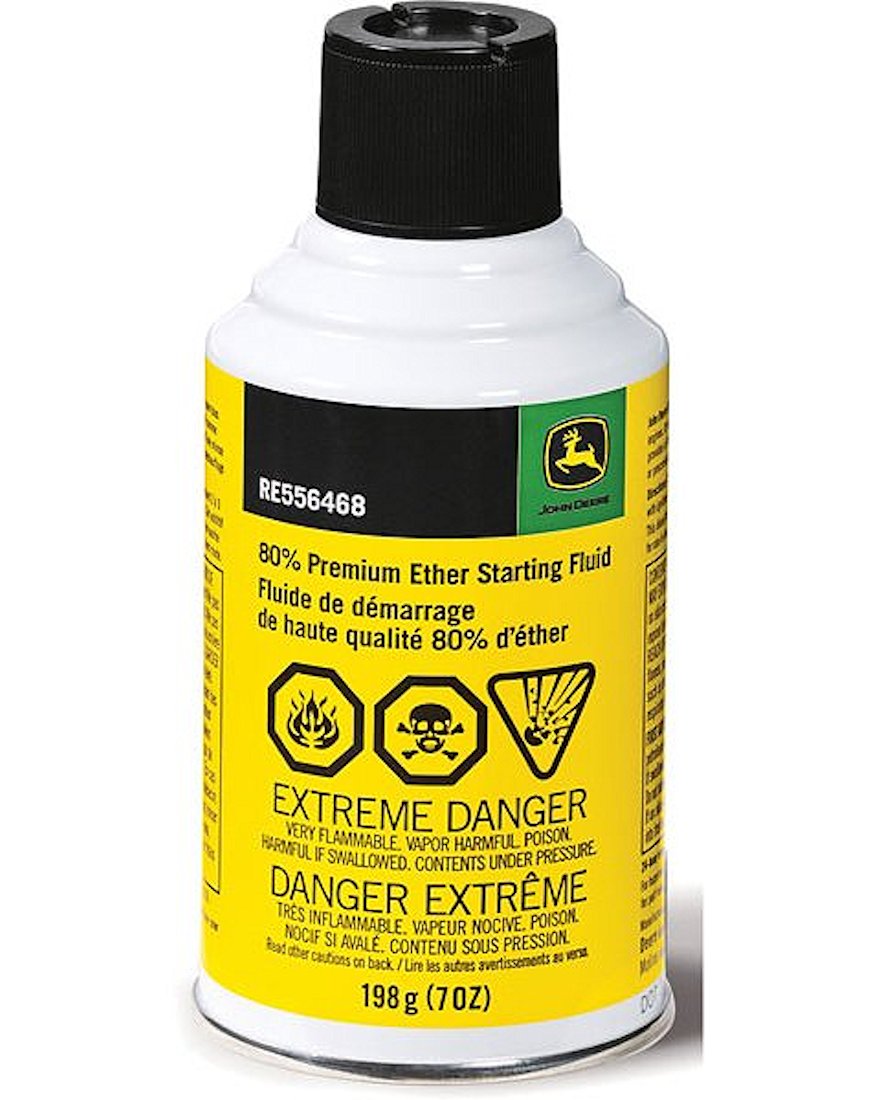 Present-day starting fluids generally have a significant heptane component. Heptane is a relative of ether which is a useable base fuel in its own right and has a relatively low self-ignition temperature of 220 °C, a little higher than that of ether at 188 °C. Its presence in the brew nevertheless seems to upset the apple cart by raising the self-ignition temperature of the overall fuel mixture. A test using Gunk Liquid Fire, which has 60% ether, revealed that the test fixed-compression Drone would start and run on this fuel but was not at all happy and showed clear symptoms of under-compression.
Present-day starting fluids generally have a significant heptane component. Heptane is a relative of ether which is a useable base fuel in its own right and has a relatively low self-ignition temperature of 220 °C, a little higher than that of ether at 188 °C. Its presence in the brew nevertheless seems to upset the apple cart by raising the self-ignition temperature of the overall fuel mixture. A test using Gunk Liquid Fire, which has 60% ether, revealed that the test fixed-compression Drone would start and run on this fuel but was not at all happy and showed clear symptoms of under-compression.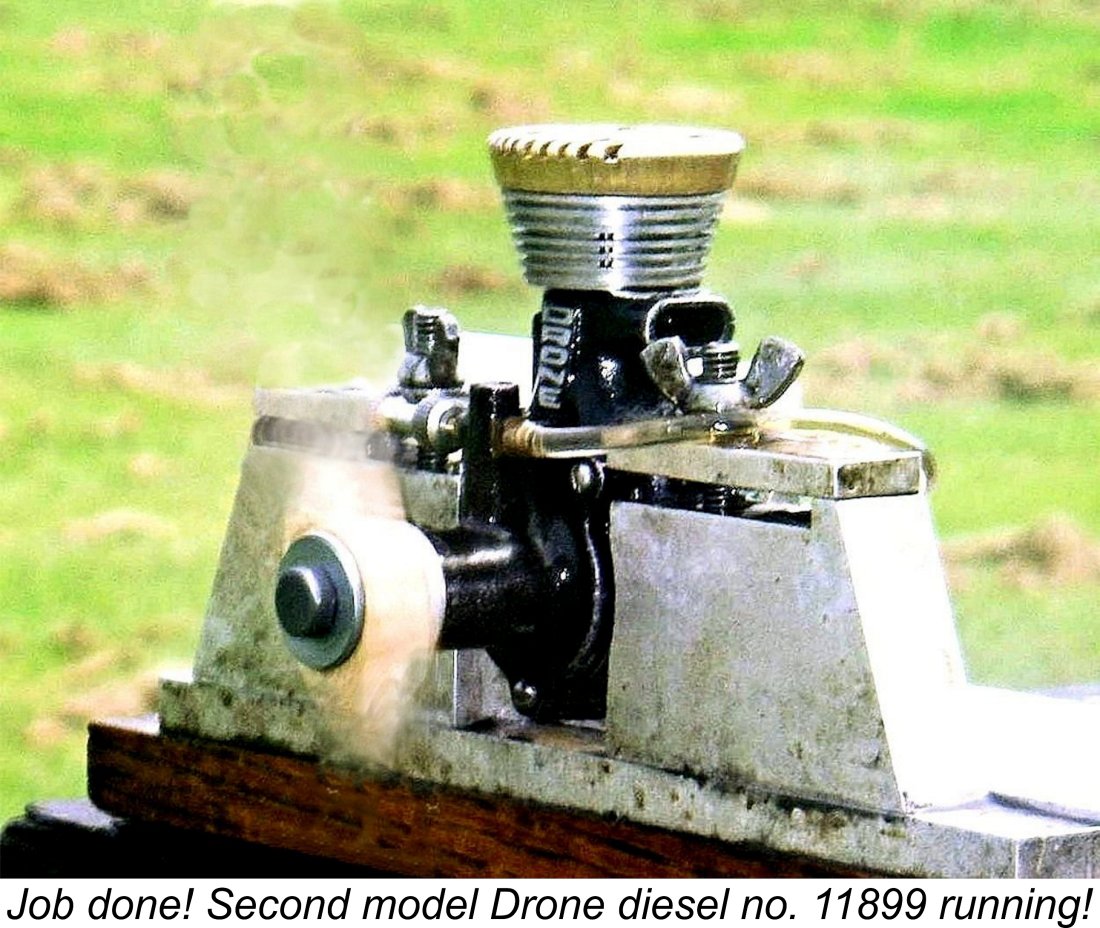 To start from cold, it's actually best to set the needle if anything a little on the lean side (the opposite of the usual approach!). The makers recommended around 4 turns of the needle for starting, and this recommendation appears to work quite well for the most part if the needle valve assembly is original. At least it's a good setting from which to begin.
To start from cold, it's actually best to set the needle if anything a little on the lean side (the opposite of the usual approach!). The makers recommended around 4 turns of the needle for starting, and this recommendation appears to work quite well for the most part if the needle valve assembly is original. At least it's a good setting from which to begin.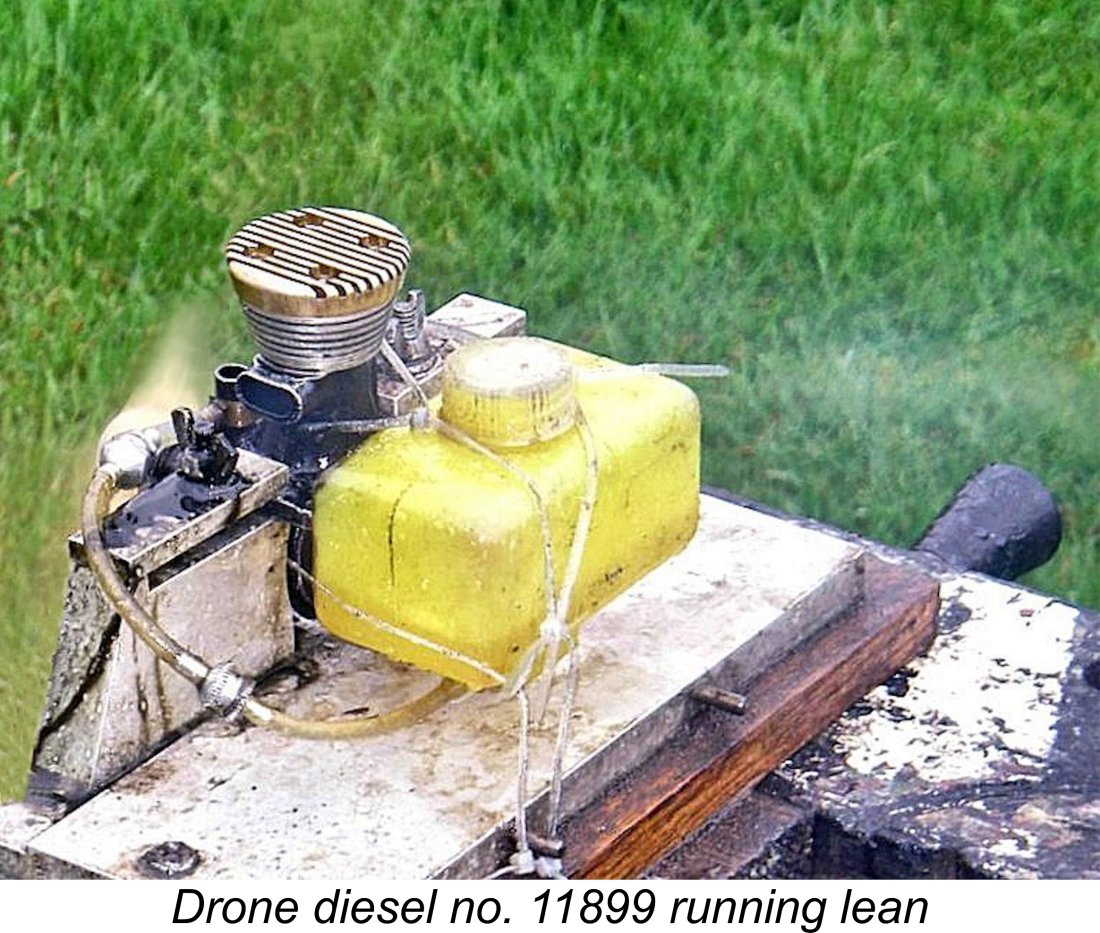
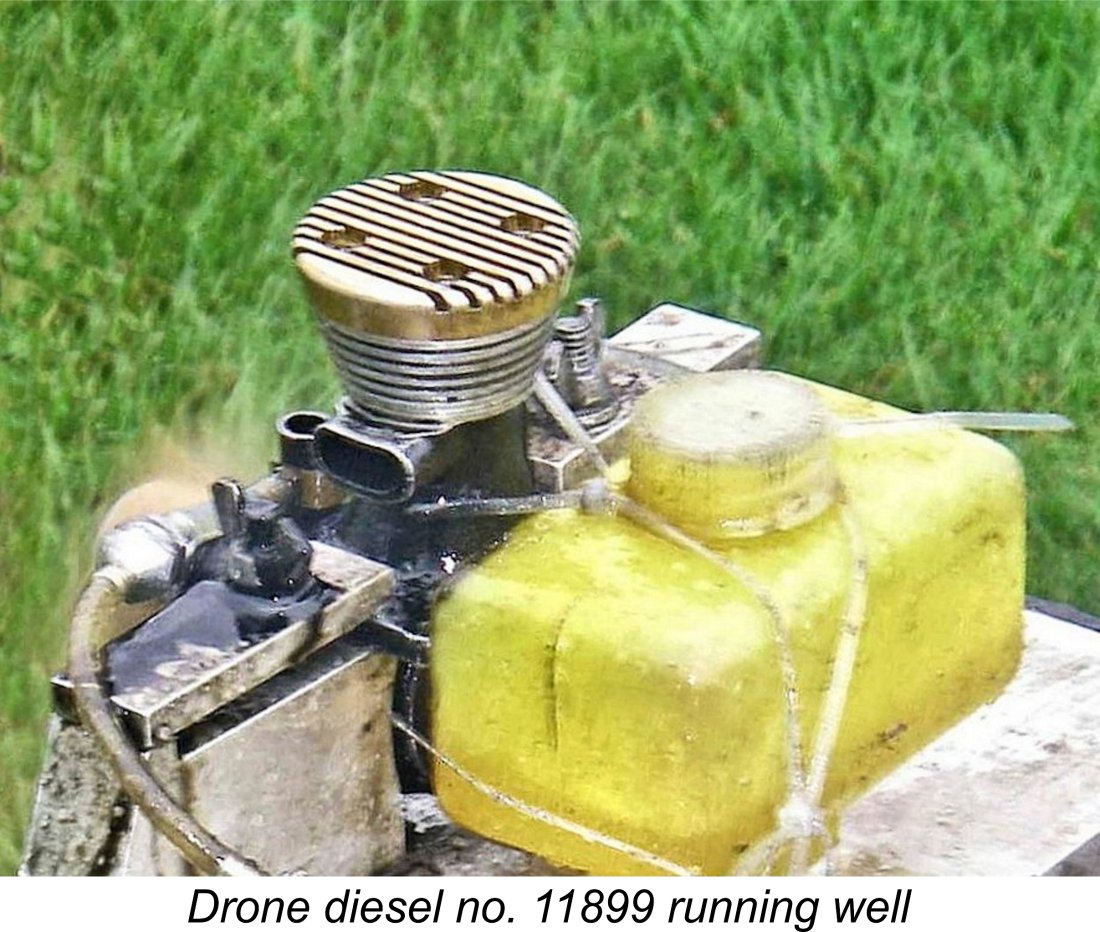 Once running, fixed compression diesels respond very differently to the needle than their variable-compression successors. Misfiring and detonation with puffs of white smoke mean a lean mixture - pull the needle out until the engine runs smoothly without detonation and the exhaust clears. Go too rich and the engine stops abruptly with no warning whatsoever! The best setting is right in the middle between misfiring and cutting out. This setting is quickly found by trial and error. In this condition the engine will run extremely smoothly and will keep this up seemingly forever with no trace of sagging and a remarkably clear exhaust with almost no visible smoke.
Once running, fixed compression diesels respond very differently to the needle than their variable-compression successors. Misfiring and detonation with puffs of white smoke mean a lean mixture - pull the needle out until the engine runs smoothly without detonation and the exhaust clears. Go too rich and the engine stops abruptly with no warning whatsoever! The best setting is right in the middle between misfiring and cutting out. This setting is quickly found by trial and error. In this condition the engine will run extremely smoothly and will keep this up seemingly forever with no trace of sagging and a remarkably clear exhaust with almost no visible smoke.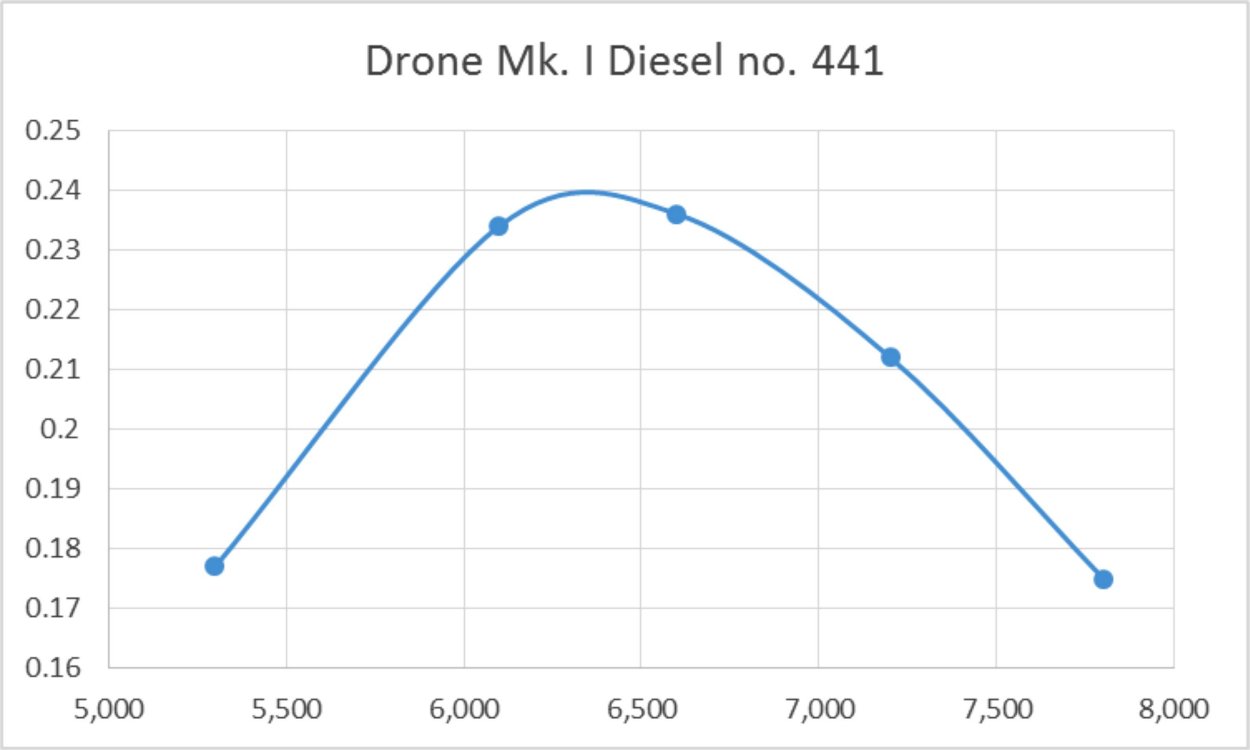
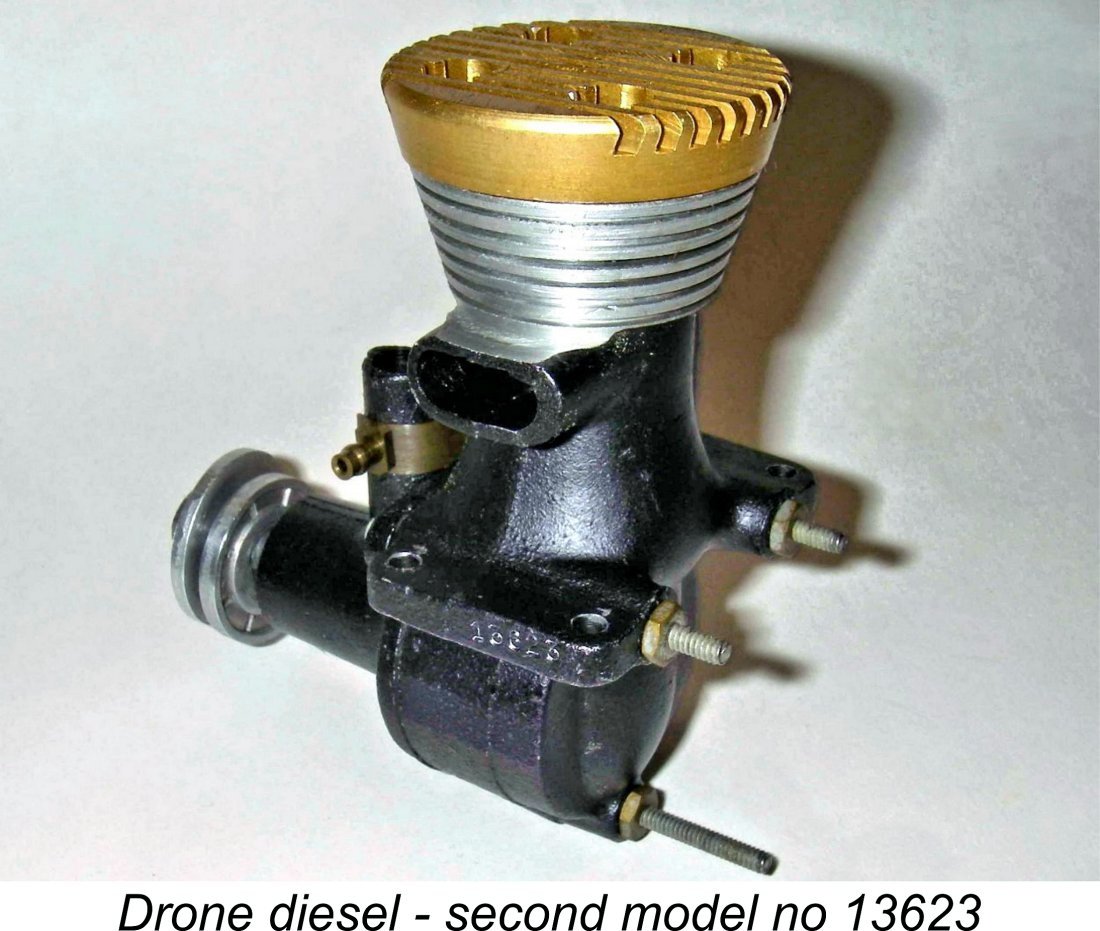 The advantages of the second model Drone have been set out above. If you plan to do some serious fixed-compression running and/or flying, this is the motor with which to do it! In his previously-mentioned 1981 write-up, Gus Munich (whose all-time favourite engine this was) reported that he had a second model Drone which had over 500 running hours on it with no replacements! Only a man like Gus with 34 years of continuous experience as a Drone user at his time of writing could credibly make such a claim! My own "flyer" second model Drone has around 25 hours in my hands, and who knows how many hours before that? It looks its age but shows virtually no signs of internal wear.
The advantages of the second model Drone have been set out above. If you plan to do some serious fixed-compression running and/or flying, this is the motor with which to do it! In his previously-mentioned 1981 write-up, Gus Munich (whose all-time favourite engine this was) reported that he had a second model Drone which had over 500 running hours on it with no replacements! Only a man like Gus with 34 years of continuous experience as a Drone user at his time of writing could credibly make such a claim! My own "flyer" second model Drone has around 25 hours in my hands, and who knows how many hours before that? It looks its age but shows virtually no signs of internal wear.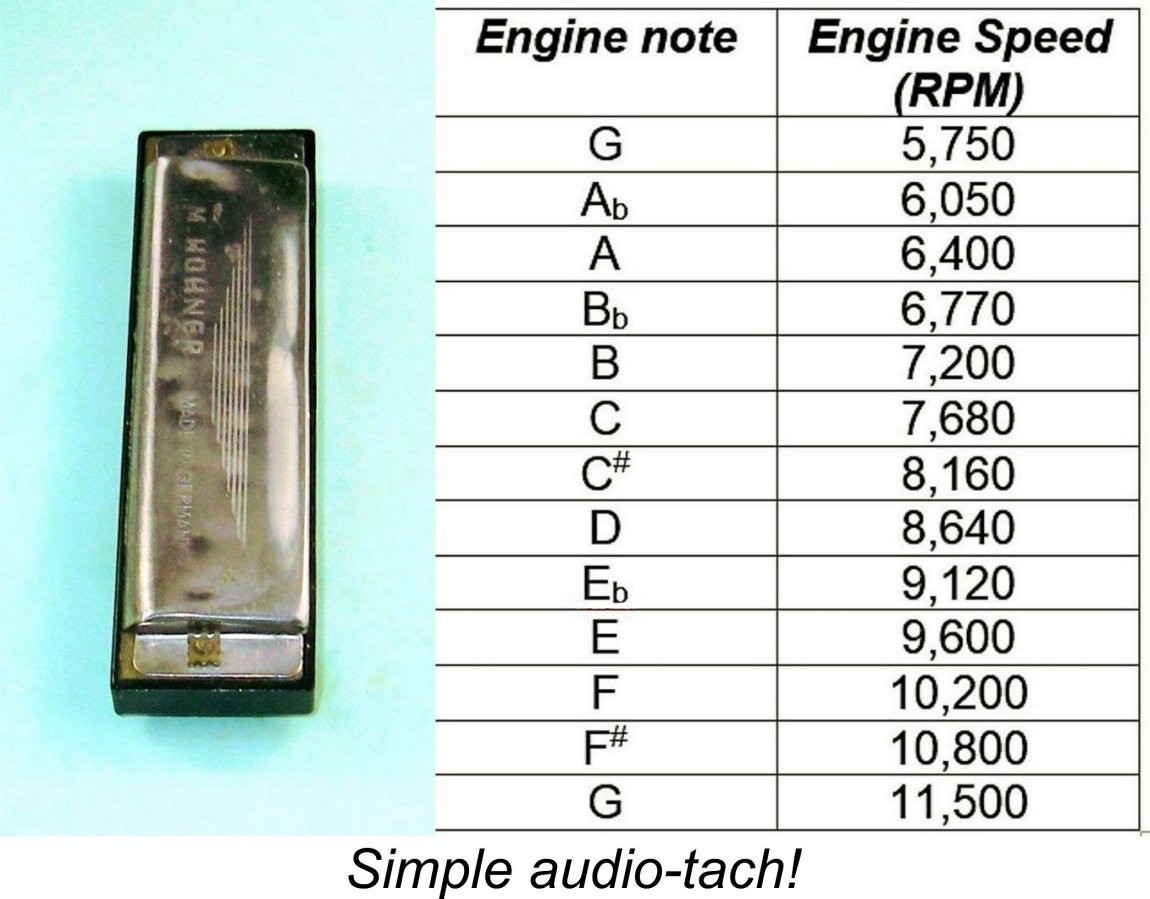
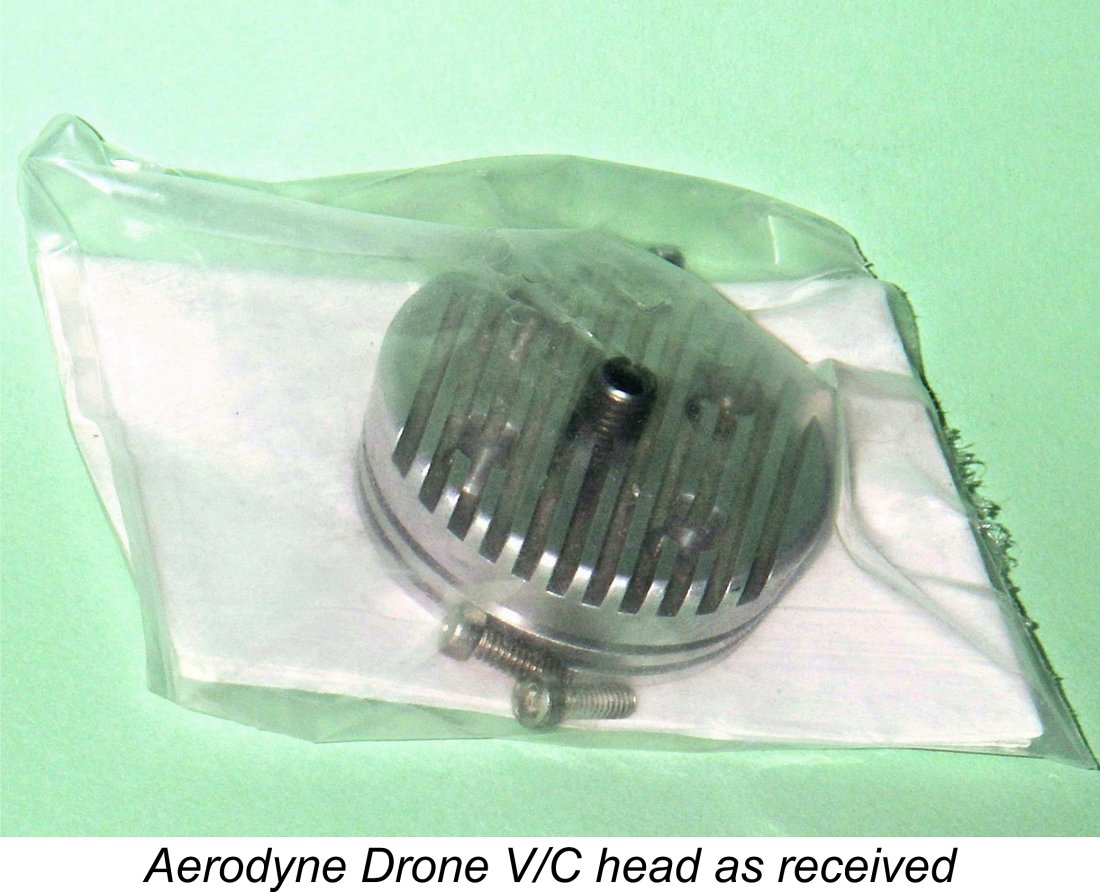 As of 2010, Allen Heinrich of Aerodyne was still offering a very well designed and finely-made variable compression head for the Drone. It’s not the same, but such heads were a good alternative if you wanted to run a Drone without all of the fixed-compression anomalies! As mentioned earlier, a variable compression head for the second model Drone was one of the accessories offered by Drone Engineering back in the day.
As of 2010, Allen Heinrich of Aerodyne was still offering a very well designed and finely-made variable compression head for the Drone. It’s not the same, but such heads were a good alternative if you wanted to run a Drone without all of the fixed-compression anomalies! As mentioned earlier, a variable compression head for the second model Drone was one of the accessories offered by Drone Engineering back in the day.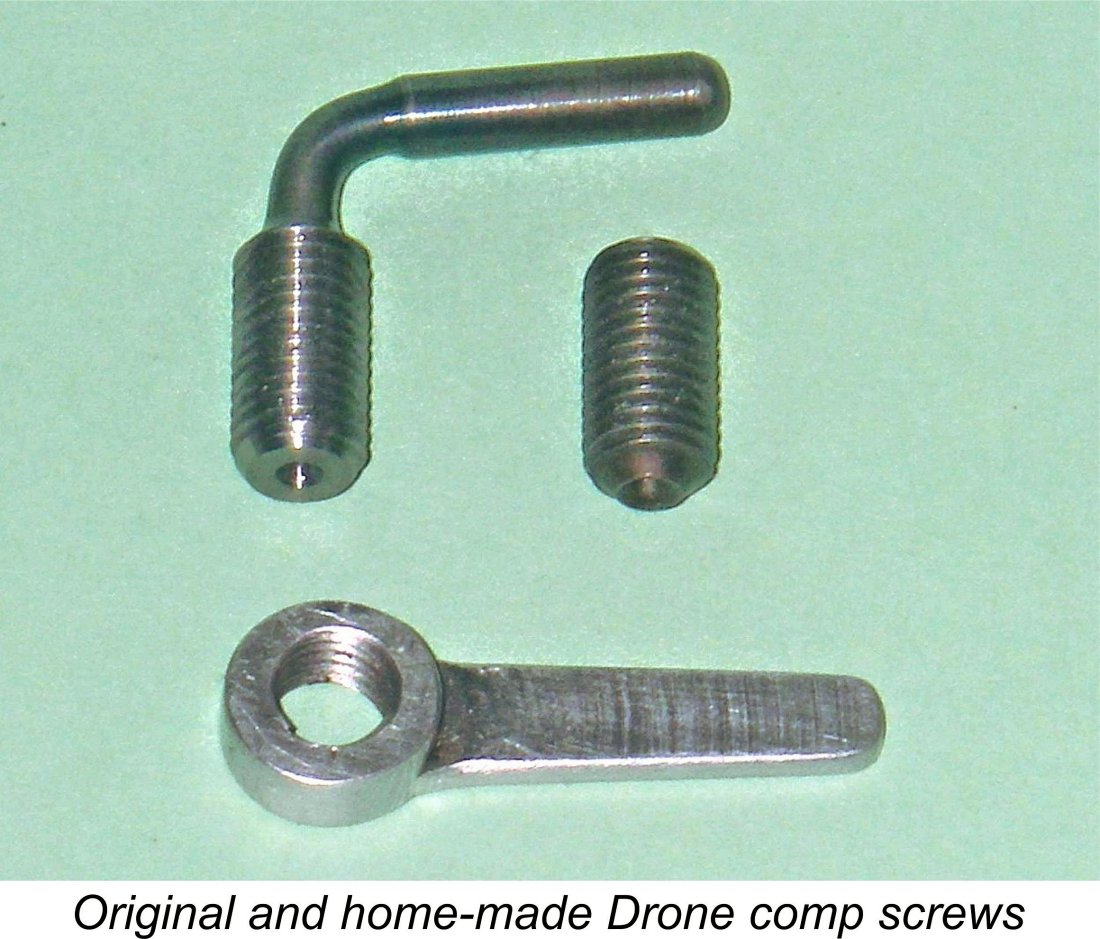 A set of four 5-40 screws was also provided to secure the head to the engine, although Allen's instruction sheet correctly noted that many Drones encountered today are threaded 6-32 - whether by the factory or by owners is unclear. The example that I chose to use for this test had 6-32 screws (as do most of my examples), and the holes (but not the sockets) in the Aerodyne head had to be very slightly enlarged to accept the Allen head items that I elected to use.
A set of four 5-40 screws was also provided to secure the head to the engine, although Allen's instruction sheet correctly noted that many Drones encountered today are threaded 6-32 - whether by the factory or by owners is unclear. The example that I chose to use for this test had 6-32 screws (as do most of my examples), and the holes (but not the sockets) in the Aerodyne head had to be very slightly enlarged to accept the Allen head items that I elected to use.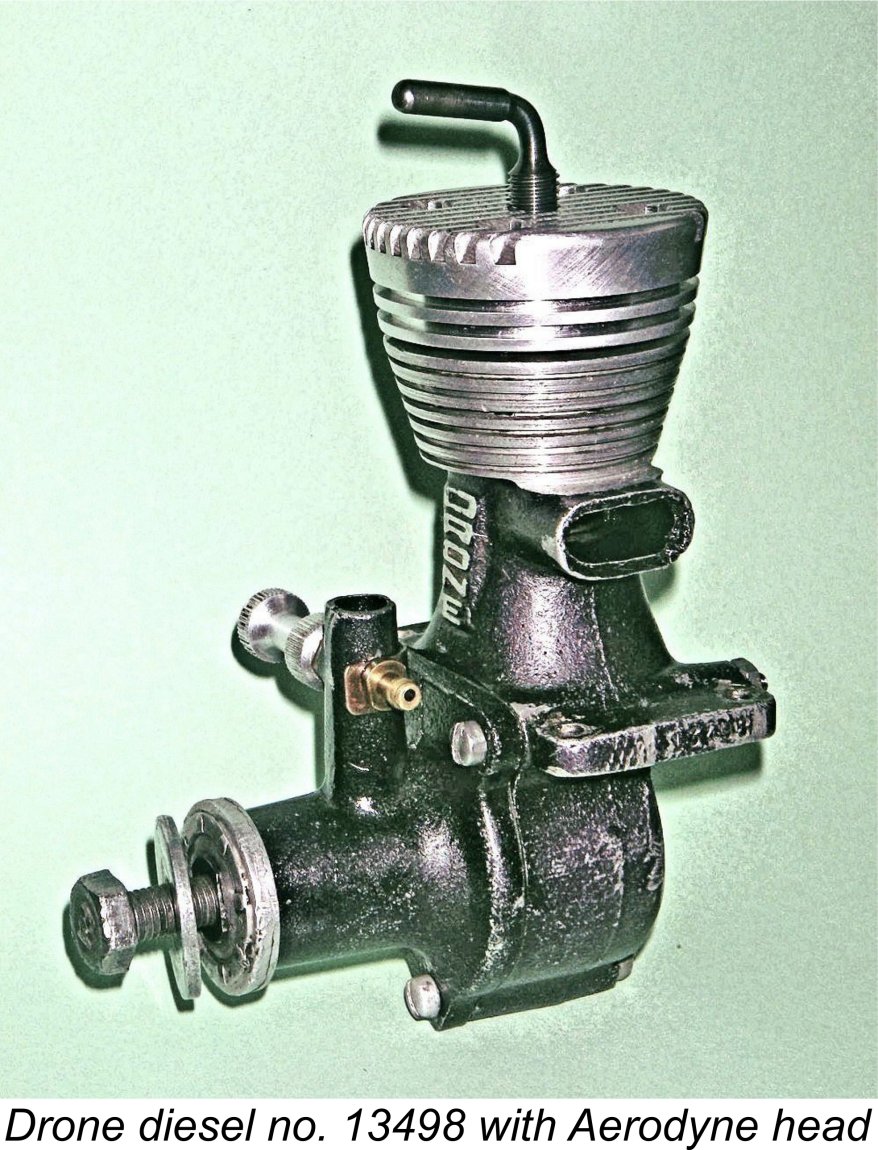
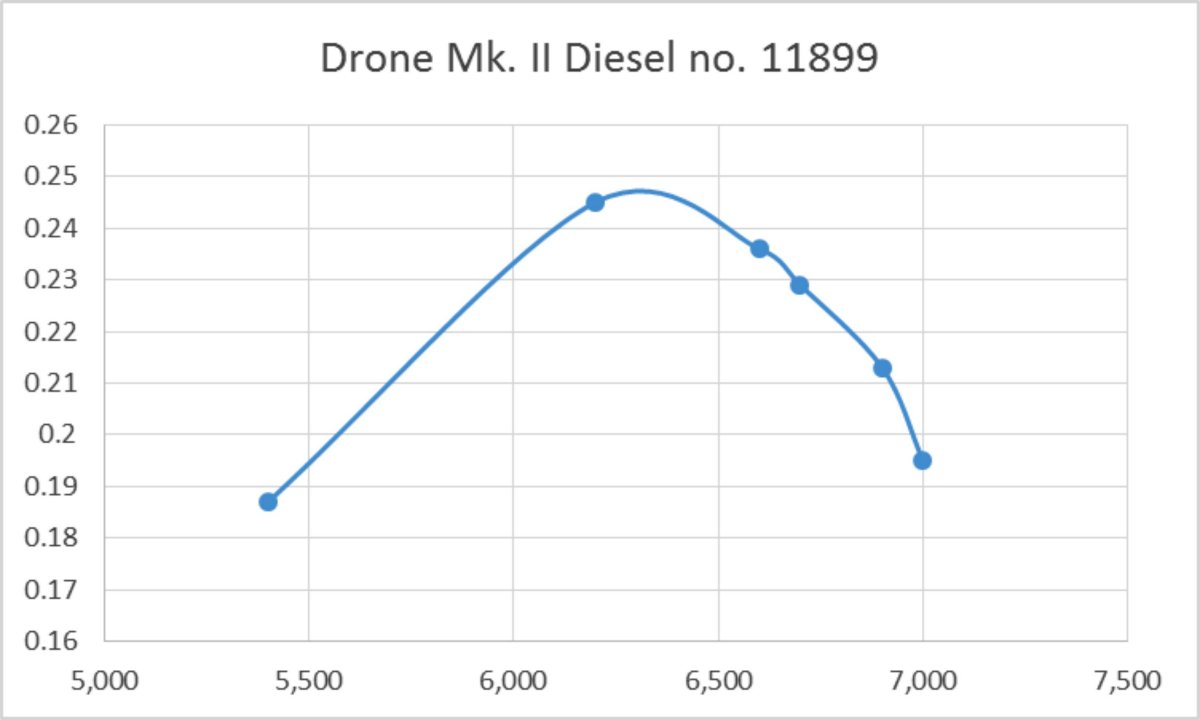
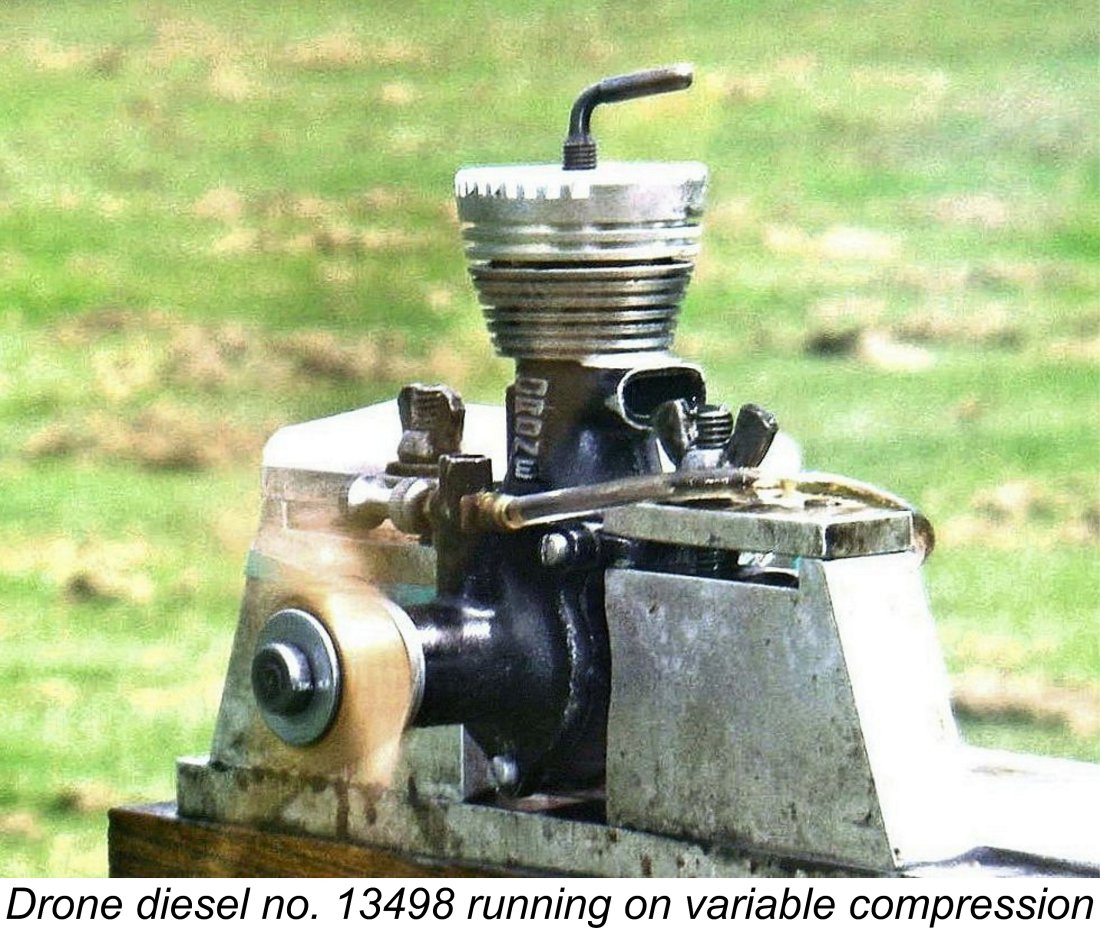 Next up was the variable compression example no. 13498, which I tested on conventional diesel fuel with kerosene and a small proportion of ignition improver. Once I established the correct compression setting, I discovered that the starting technique for this one was pretty much the same as for its fixed-compression brother - a few choked flips and then a few more hard un-choked flicks, and away it went!
Next up was the variable compression example no. 13498, which I tested on conventional diesel fuel with kerosene and a small proportion of ignition improver. Once I established the correct compression setting, I discovered that the starting technique for this one was pretty much the same as for its fixed-compression brother - a few choked flips and then a few more hard un-choked flicks, and away it went!